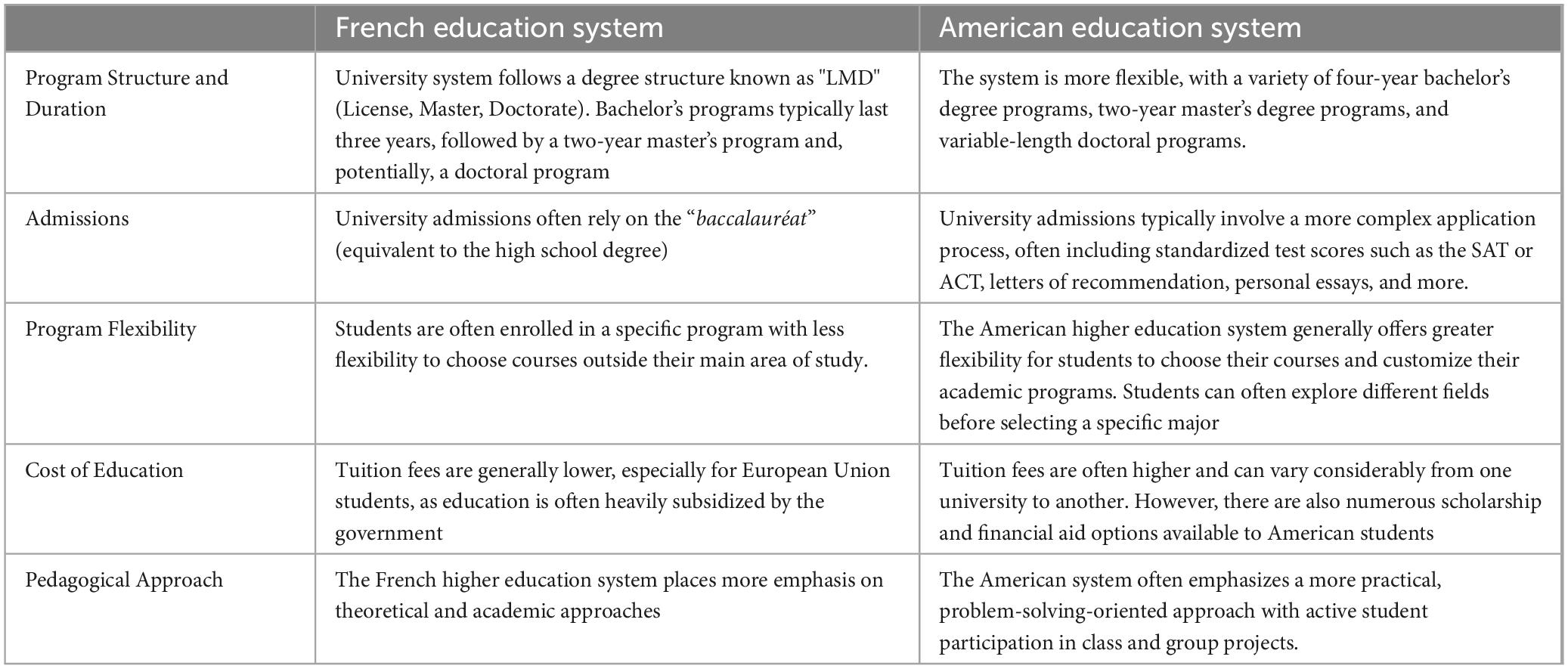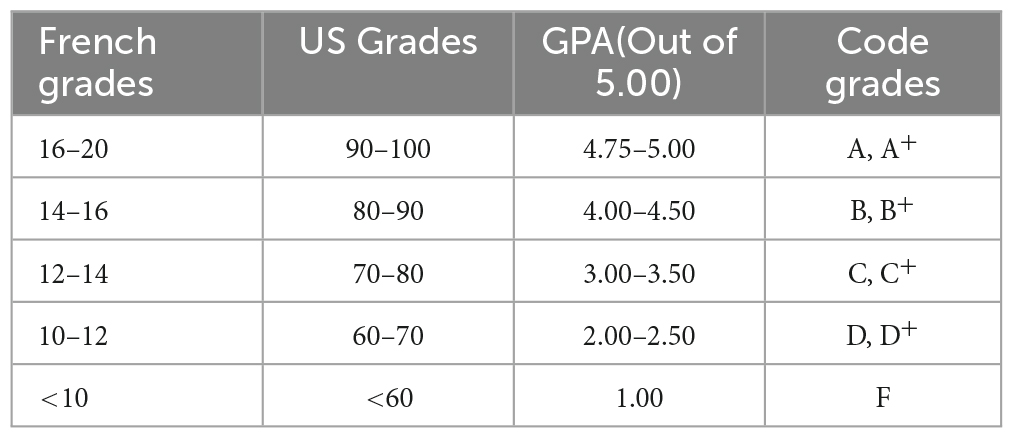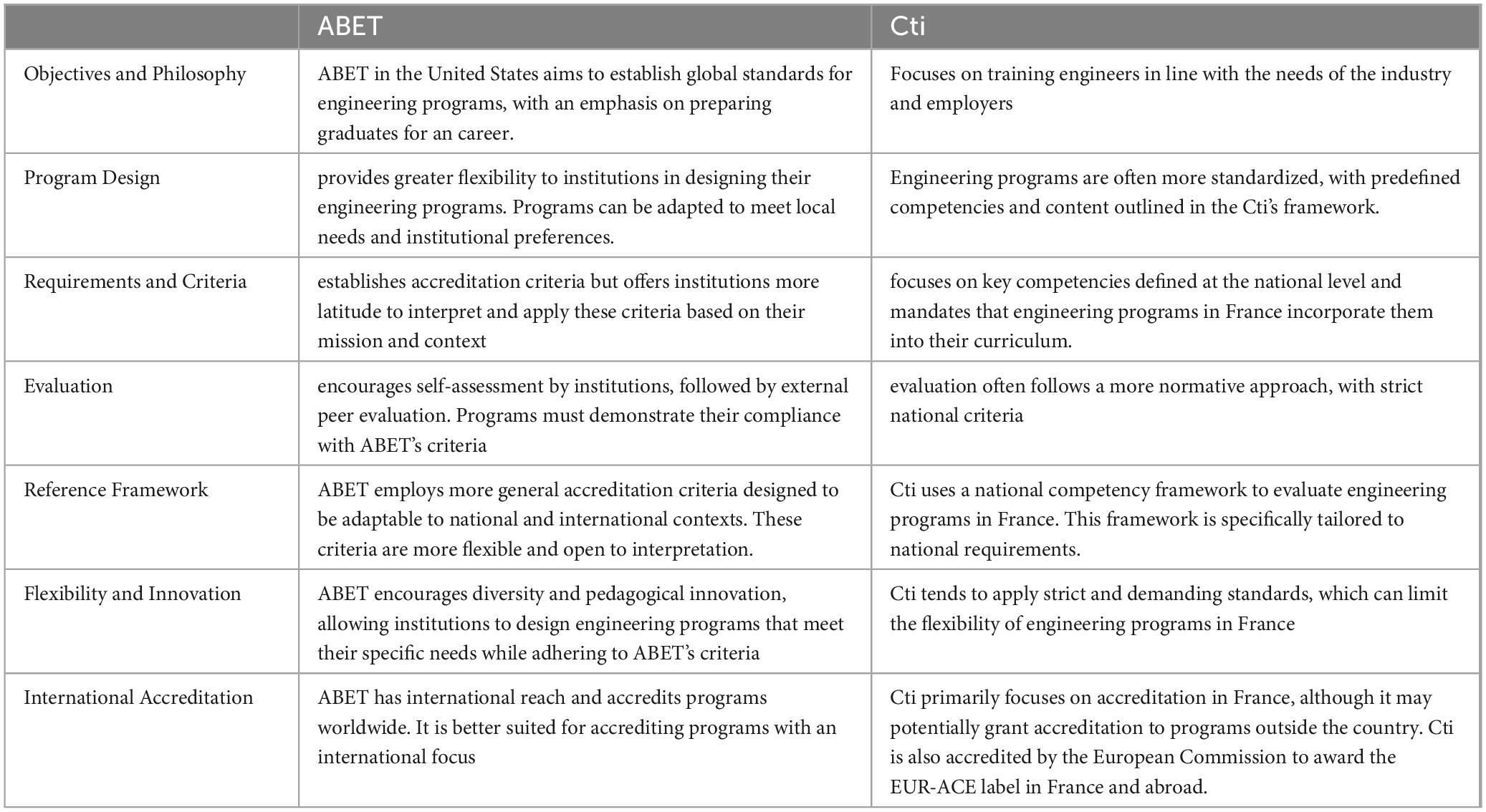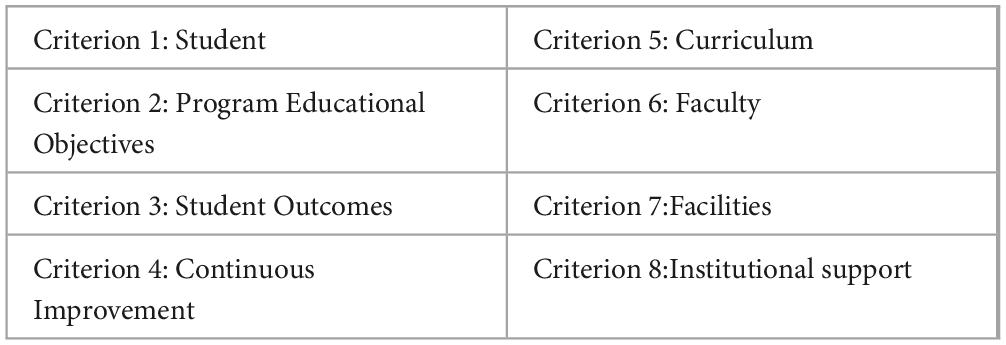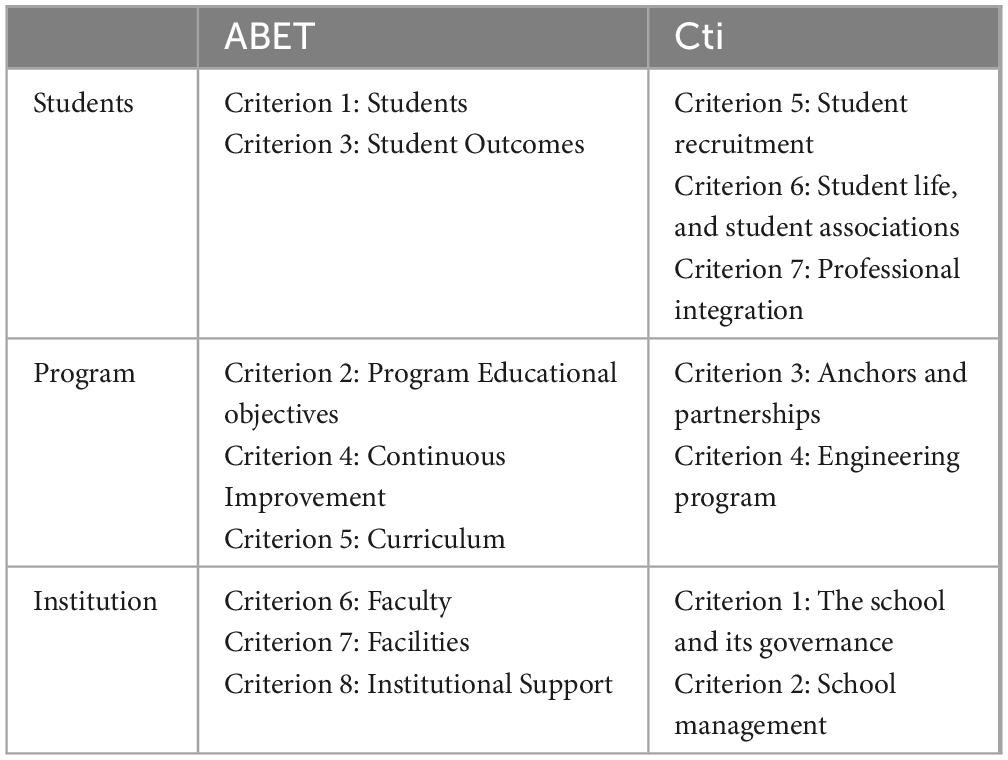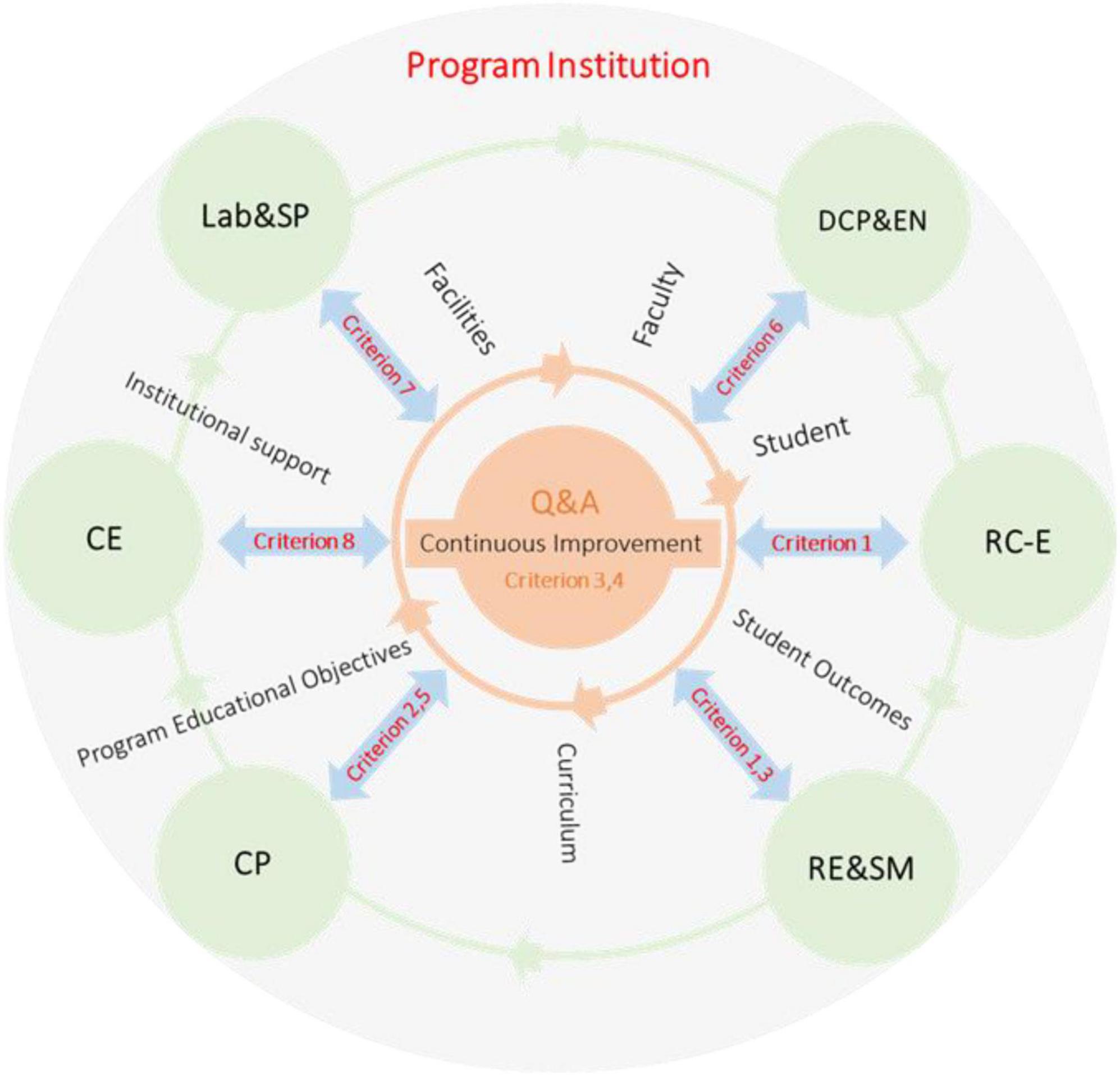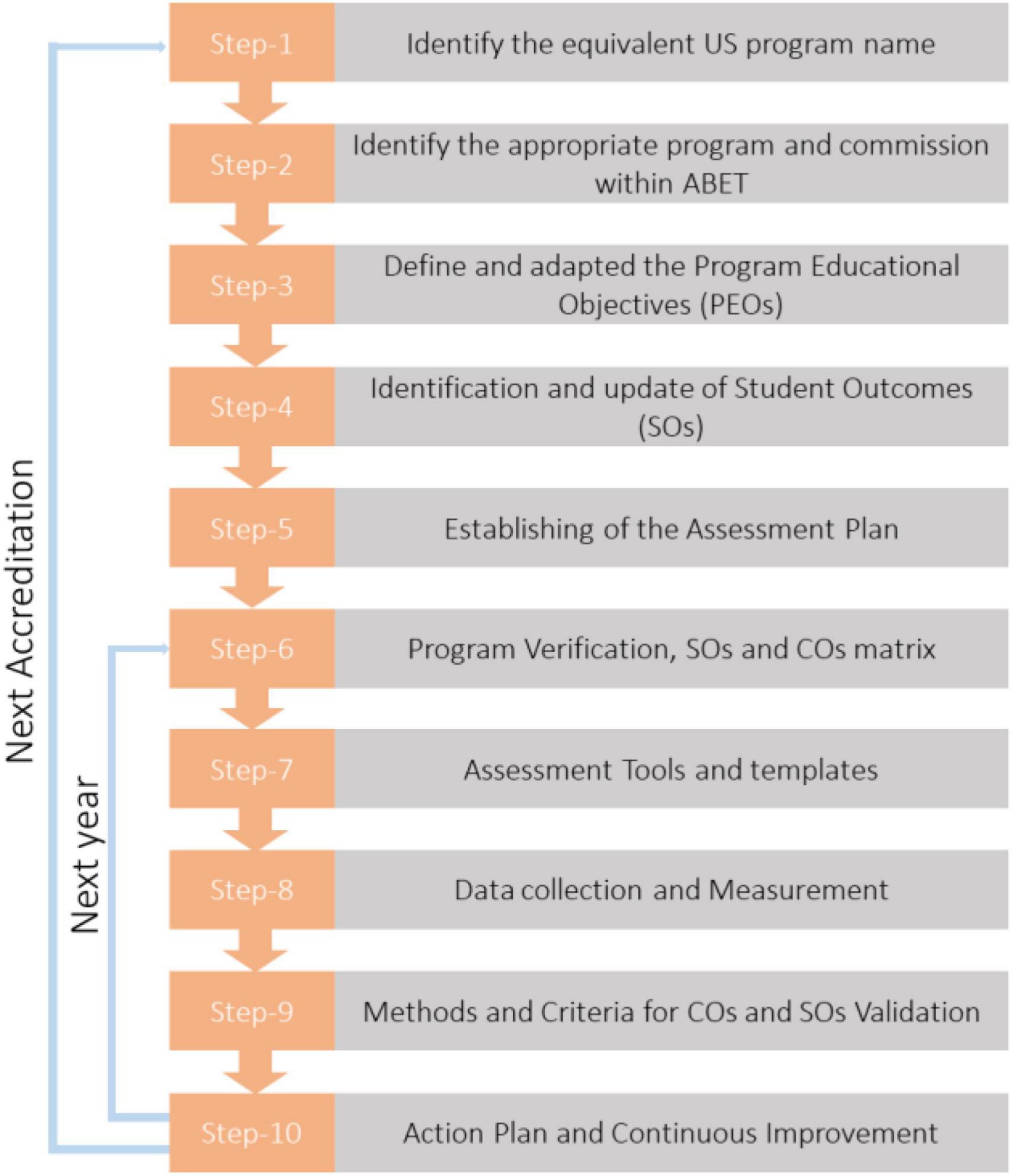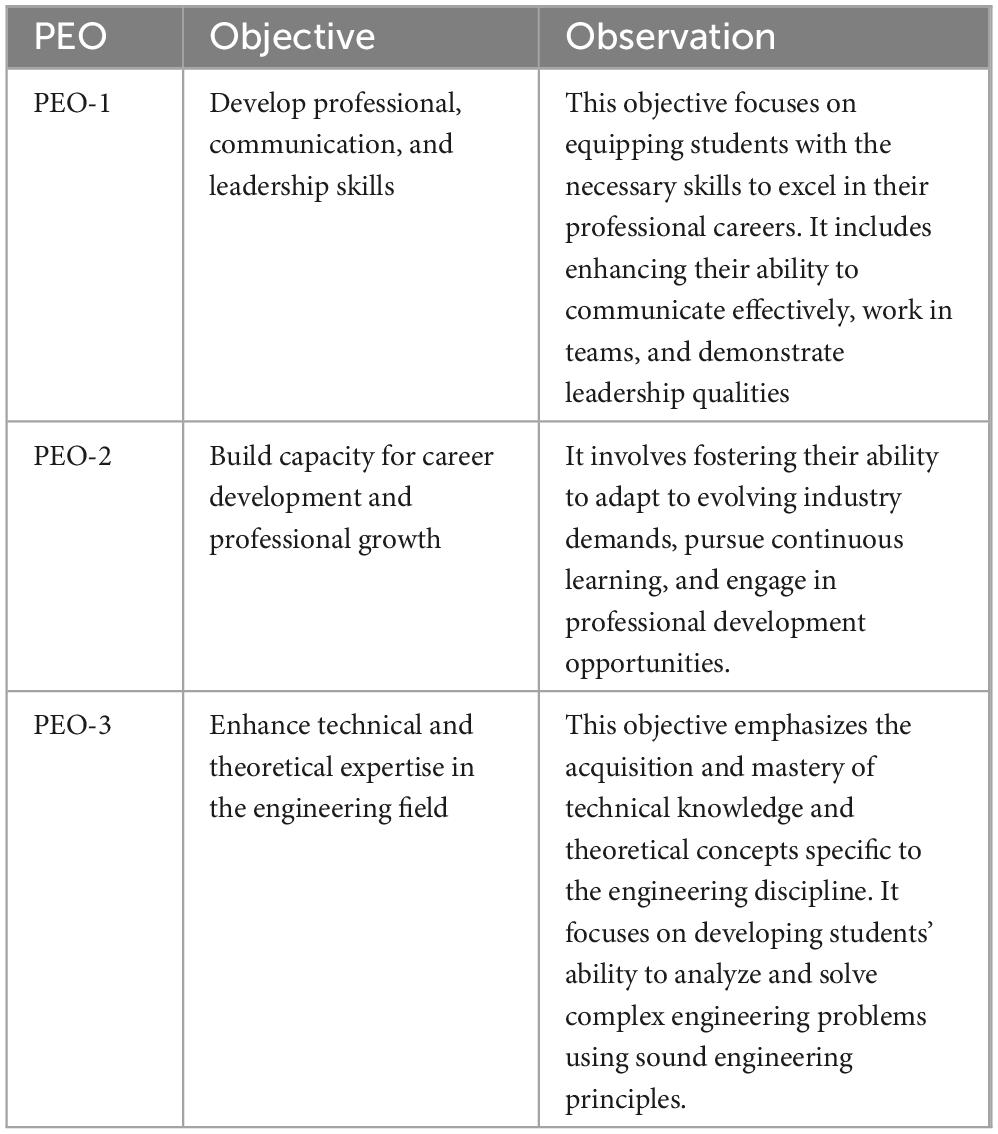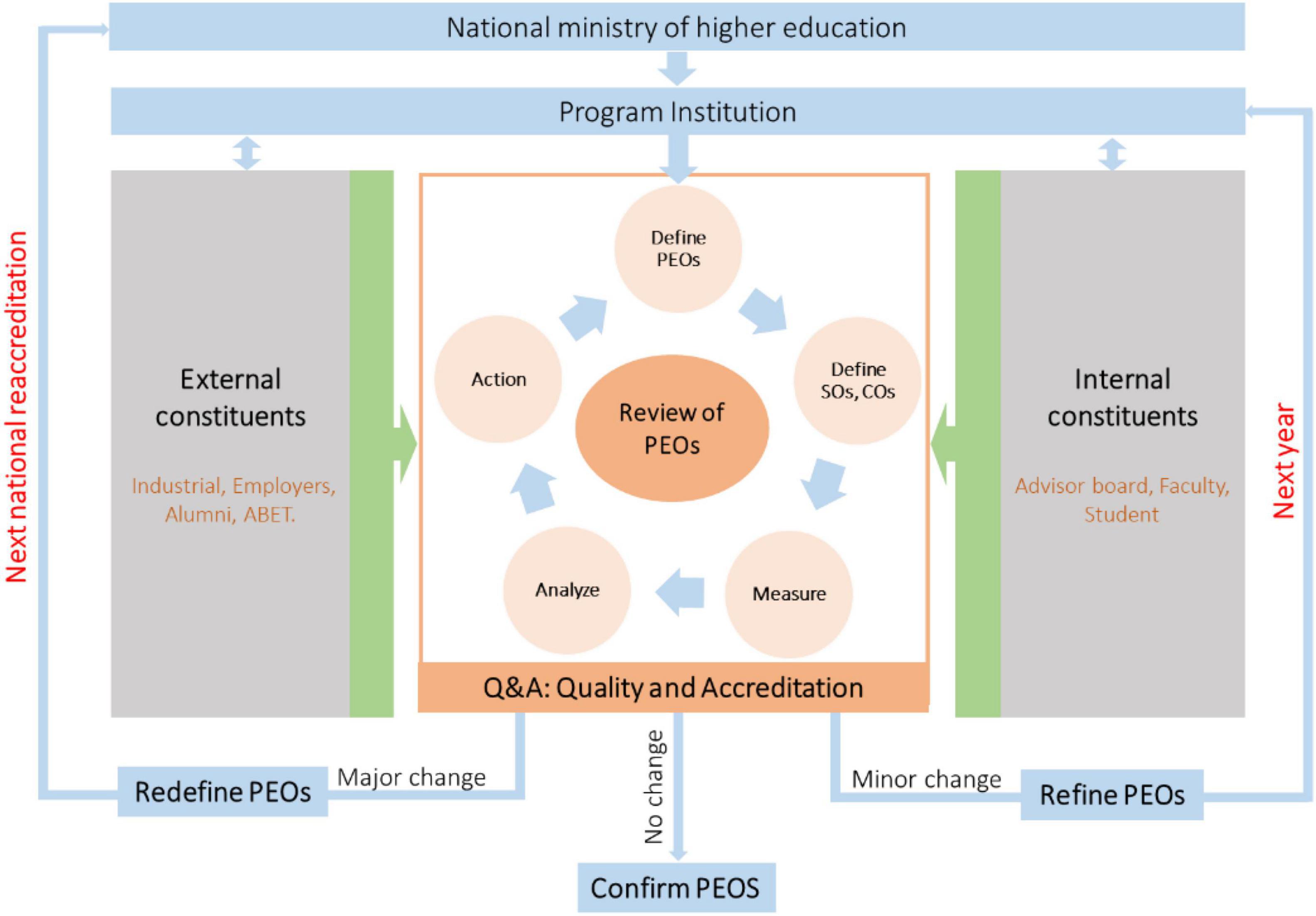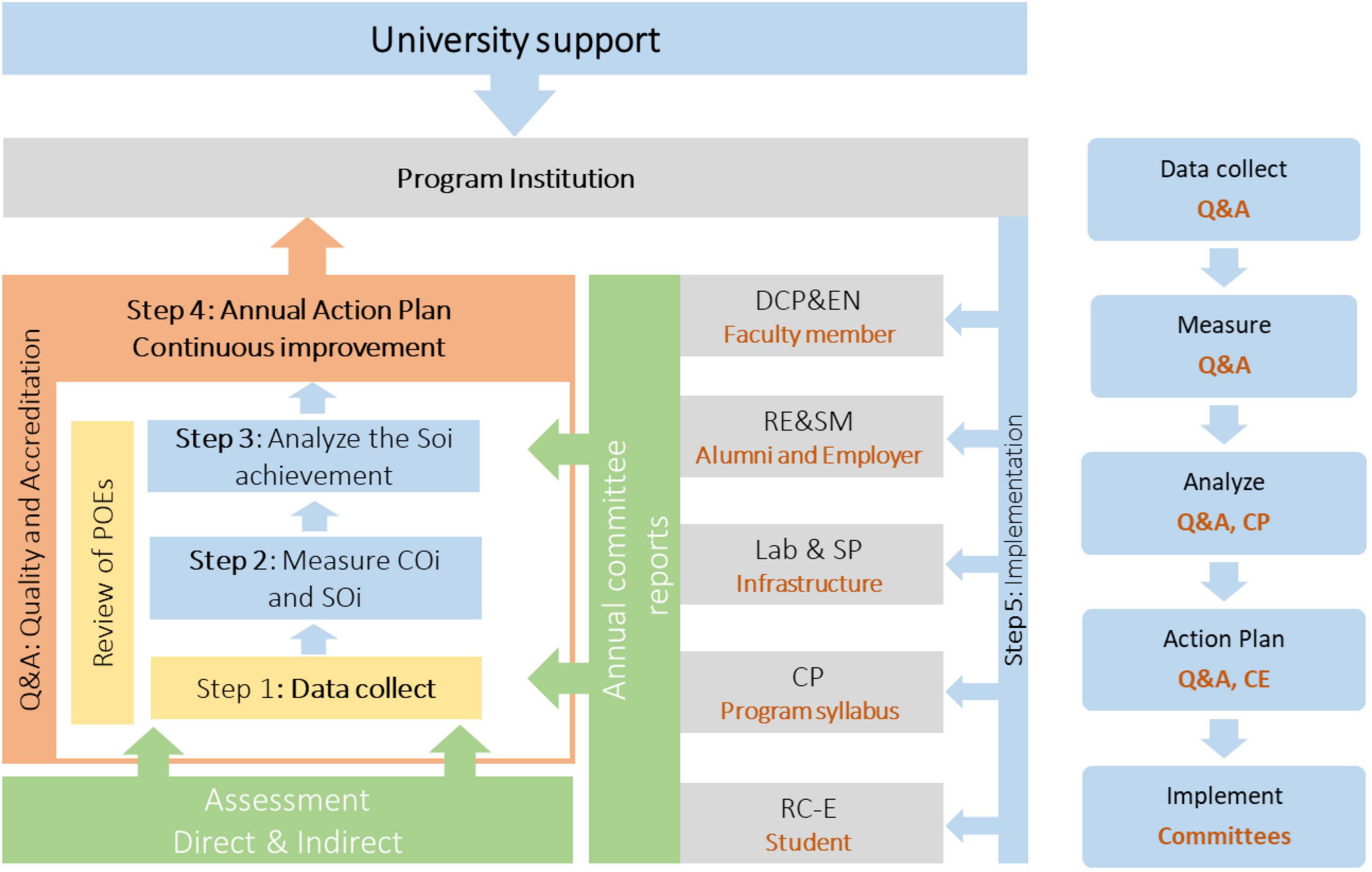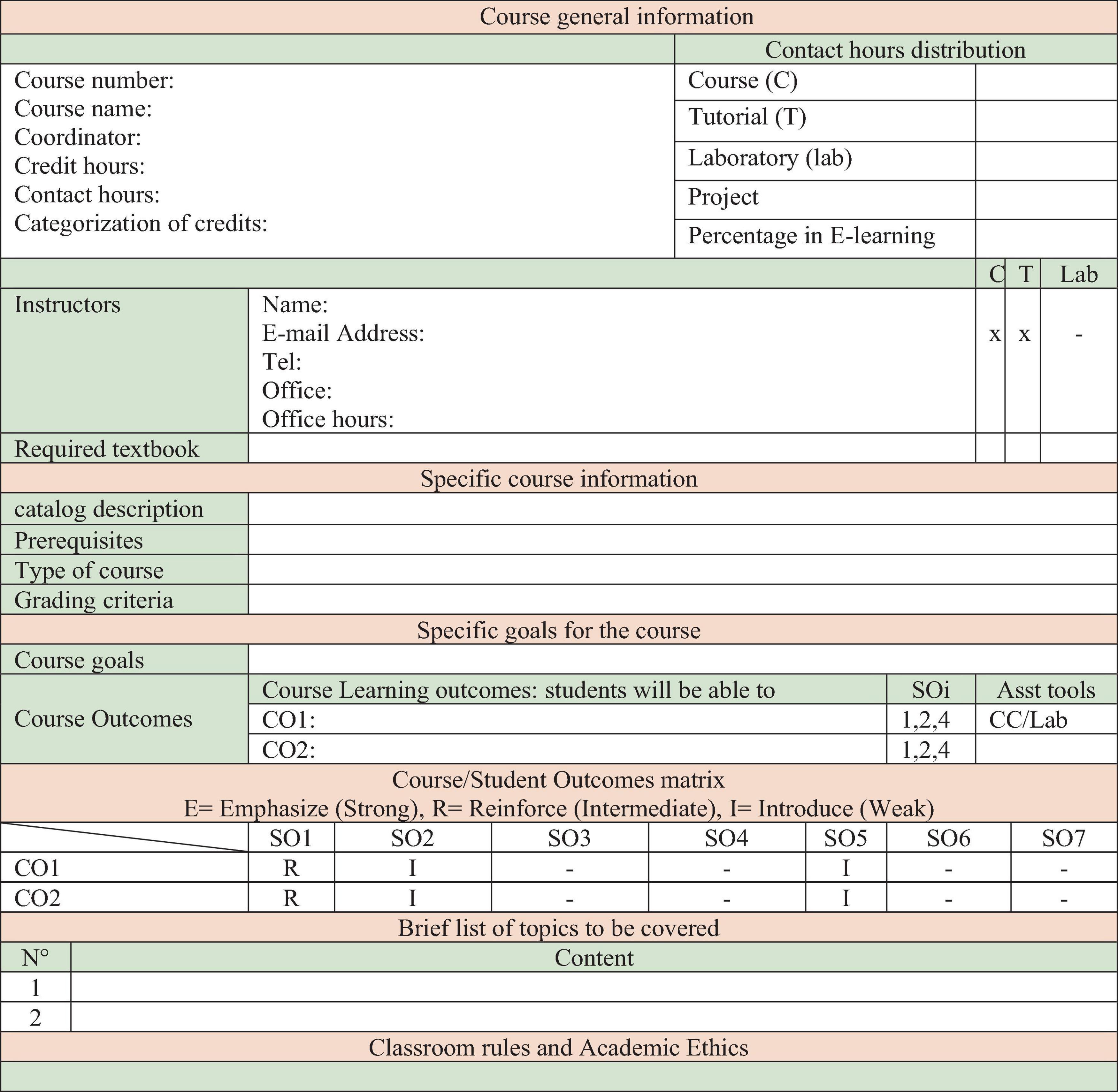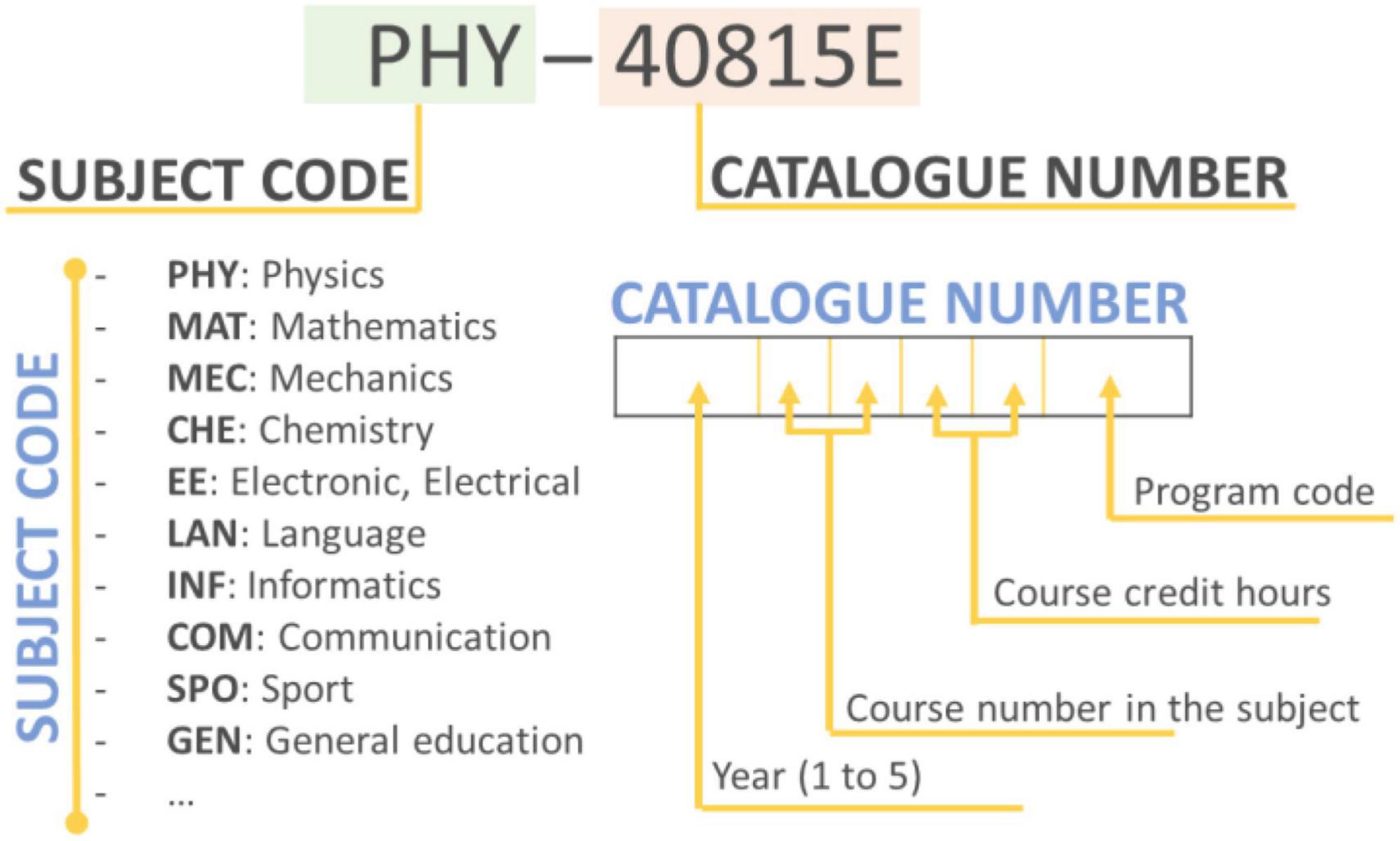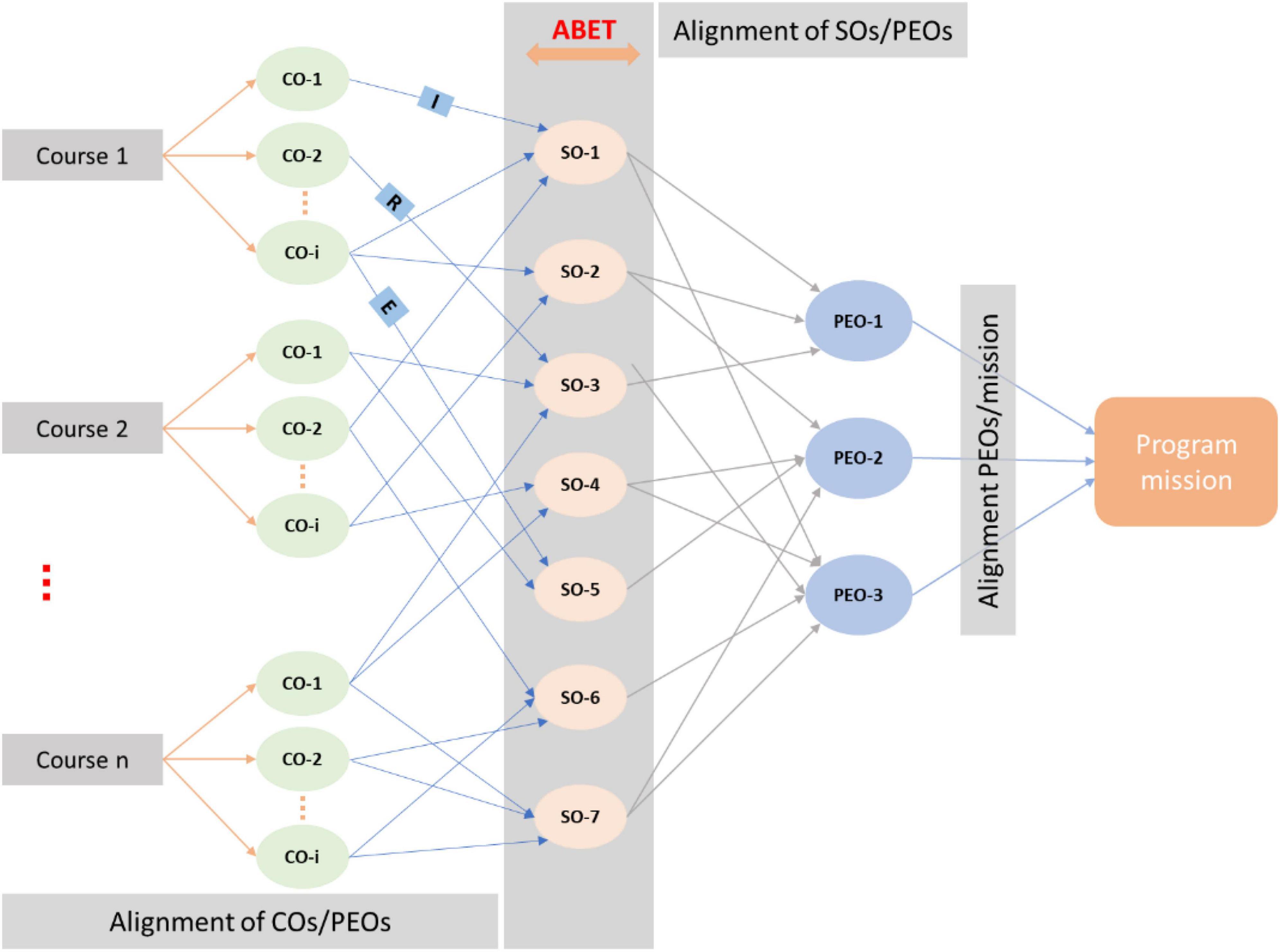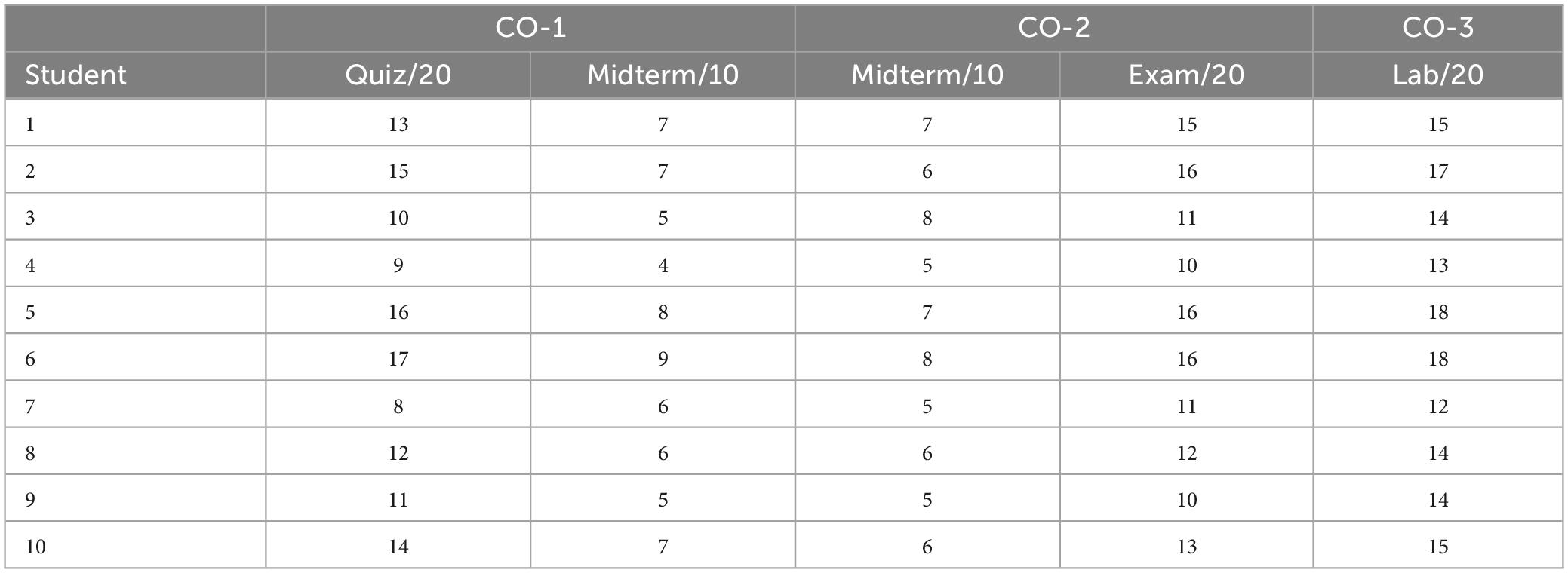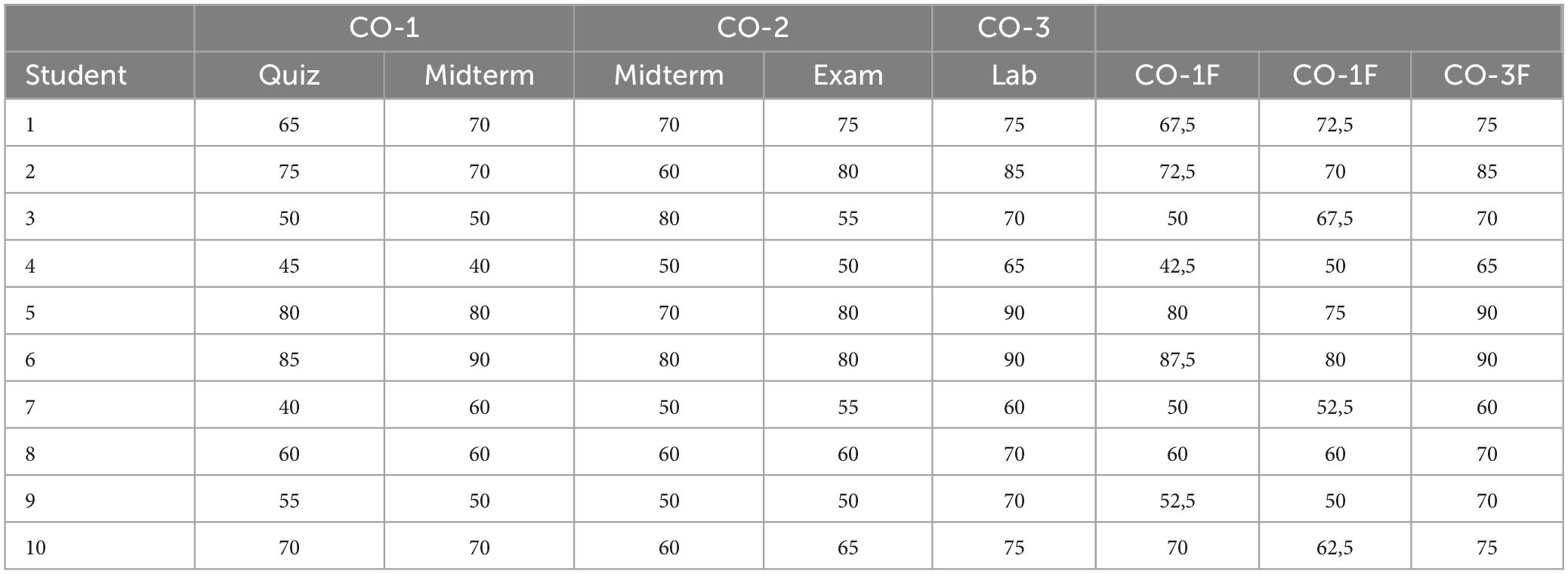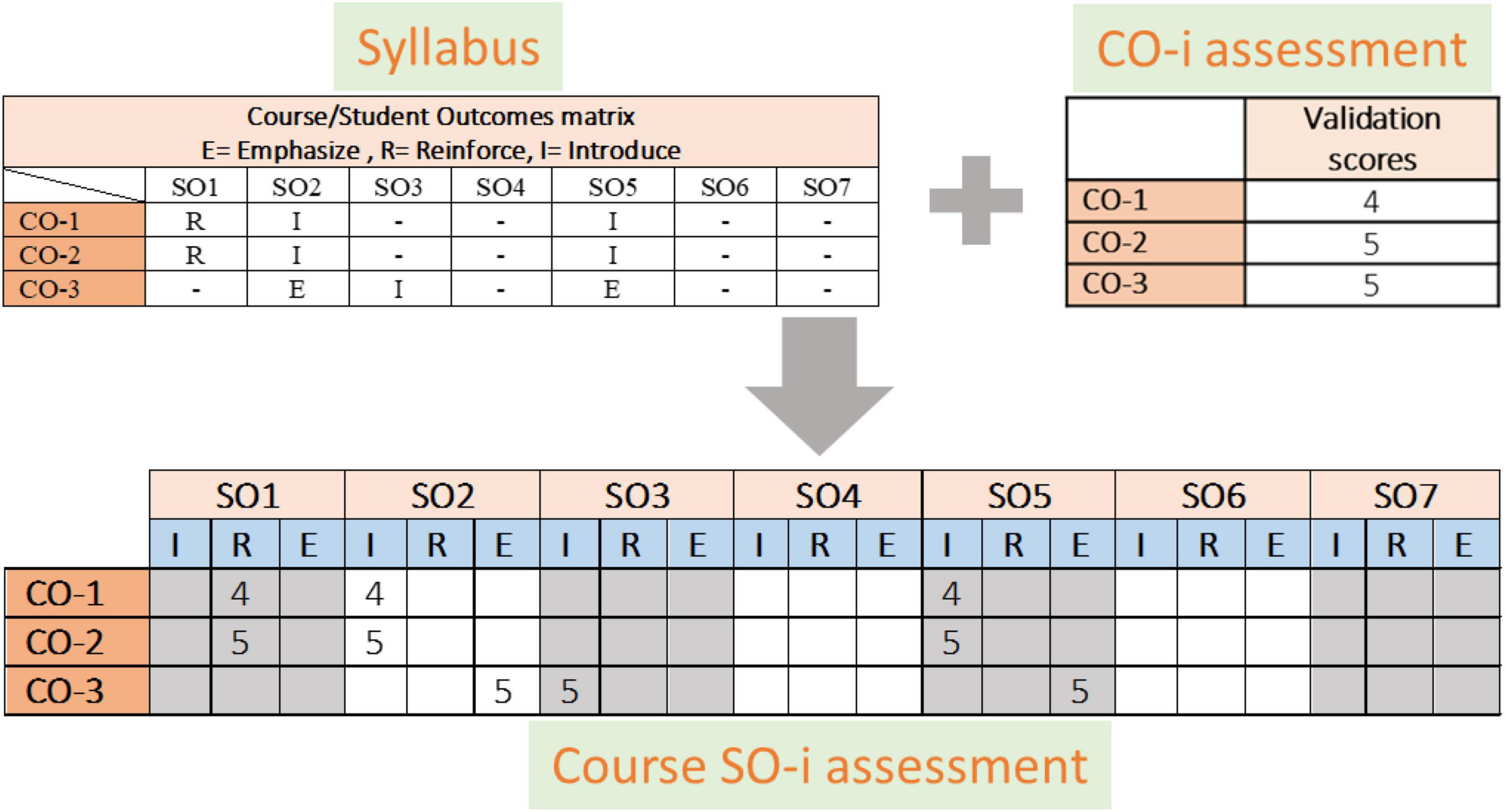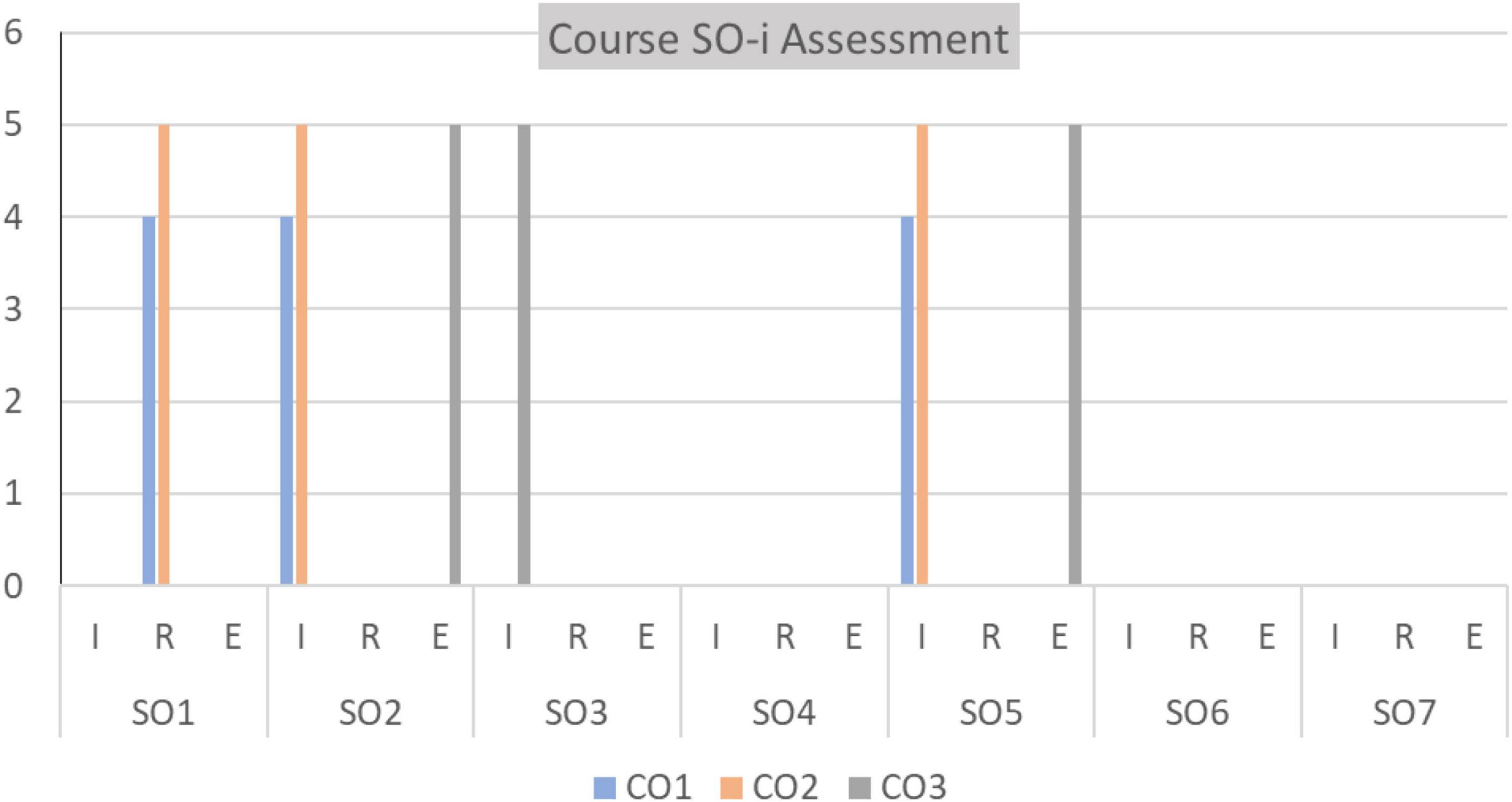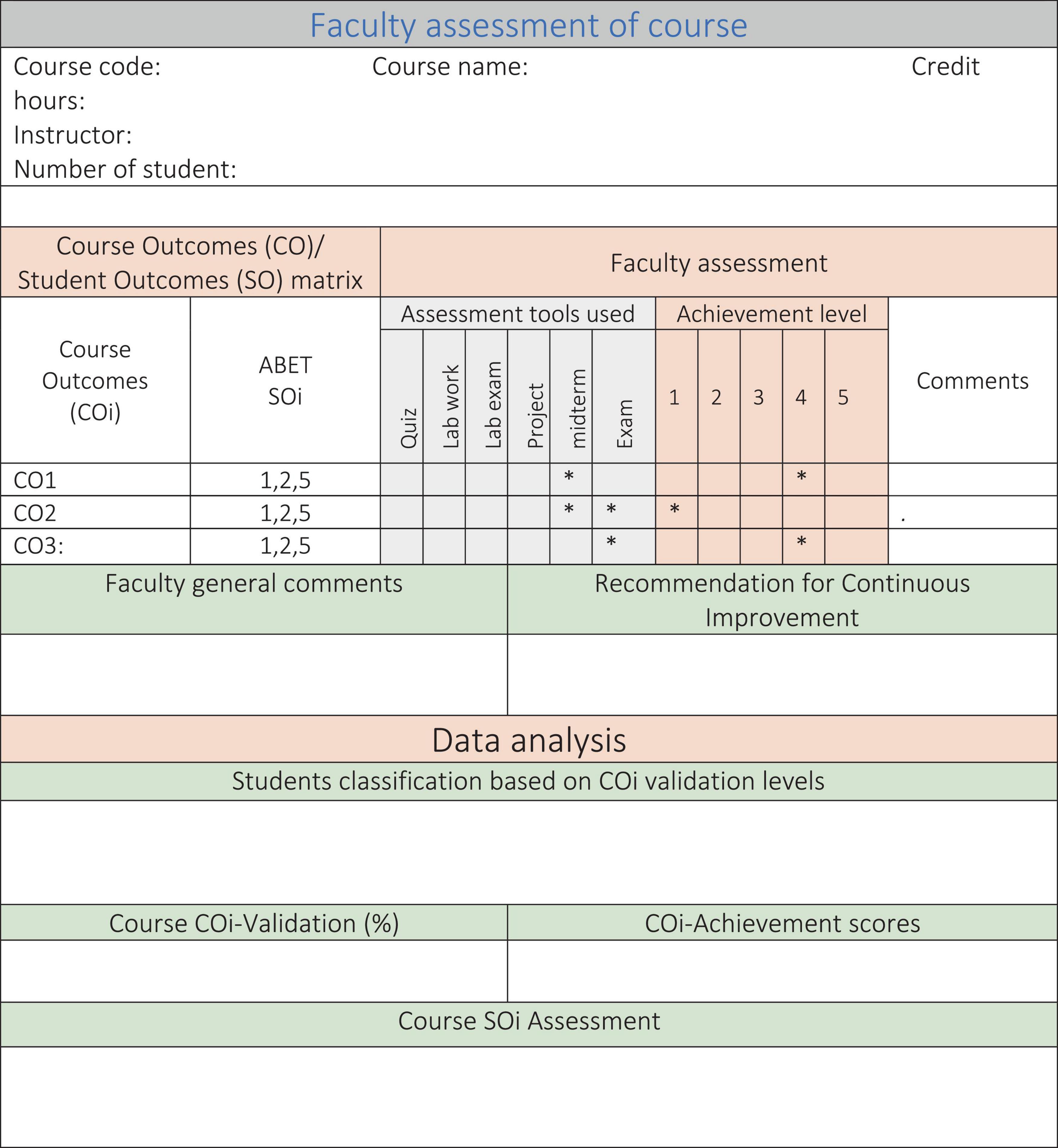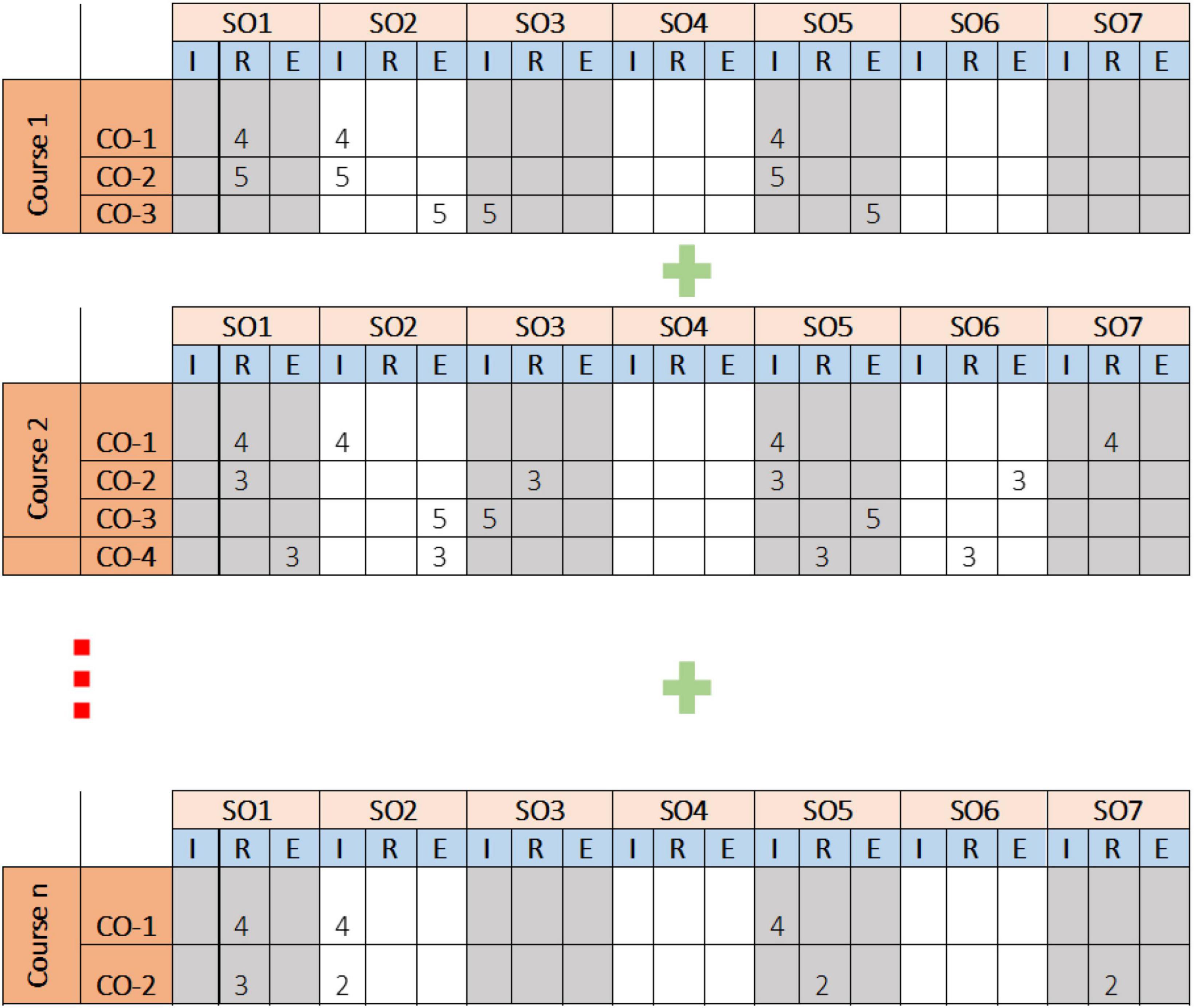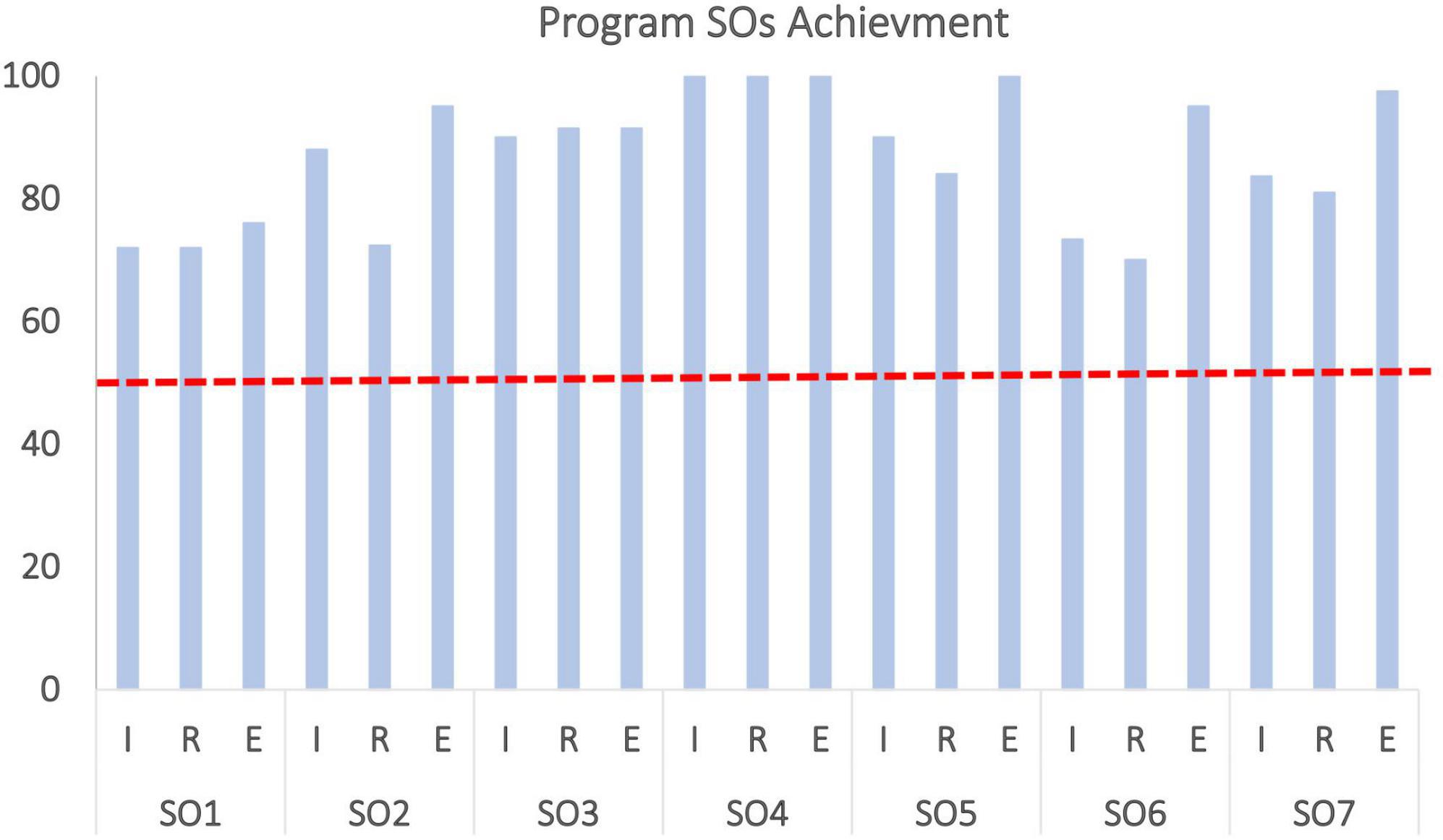- 1International University of Rabat, Technopolis Rabat-Shore Rocade Rabat-Salé, Salé, Morocco
- 2Laboratoire de Chimie Physique Macromoléculaire (LCPM), UMR CNRS-UL 7375, Université de Lorraine, Nancy, France
Introduction: In recent times, there has been a notable increase in the demand for accreditations, driven by their essential role in recognizing diplomas, elevating the quality of higher education, facilitating student mobility, enabling the pursuit of multiple degrees, and influencing university rankings. This surge in demand reflects the evolving landscape of higher education in a world that is becoming progressively interconnected and competitive.
Methods: This paper presents a comprehensive methodology for accrediting study programs in French higher education institutions worldwide that are seeking the Accreditation Board for Engineering and Technology (ABET) accreditation. ABET accreditation is a globally recognized organism of quality for education programs in engineering, computer science, and related fields. The methodology proposed in this paper focuses on aligning ABET’s requirements and standards with the specific context of the French Education System (FES). It provides clear guidelines and practical steps for higher education institutions to effectively navigate the accreditation process. The methodology covers the verification of existing study programs, identification of areas for improvement, implementation of corrective actions, and continuous progress monitoring. It emphasizes the importance of continuous improvement and aligning programs with the Program Educational Objectives (POEs). Concrete examples and best practices are shared to illustrate successful implementation of the methodology developed based on the example of the engineering college programs at our university.
Results and discussion: The results obtained in this case study demonstrate the applicability and effectiveness of this approach within a specific educational context. The approach presented in this contribution can serve as a model for other countries seeking to adapt ABET accreditation requirements to their own higher education systems, further promoting diversity and openness. This reinforces the credibility of the methodology and paves the way for its use in other institutions and programs that operate within similar systems.
1 Introduction
The history of accreditation in higher education and its relation with quality assurance (QA), particularly in the field of engineering, can be traced back to the early 20th century when the rise of industrialization and technological advancements led to a growing demand for qualified engineers. In 1932, the establishment of the Accreditation Board for Engineering and Technology (ABET) (ABET, 2023) in the United States marked a significant milestone in the development of accreditation for engineering programs. ABET was among the pioneering organizations to establish stringent educational standards for engineering schools, ensuring that graduates met industry requirements. This model gradually extended its influence worldwide, leading to the creation of similar bodies in other countries. In France, the “Commission des Titres d’Ingénieur” (Cti) was established in 1934 (Cti, n.d.) with the purpose of accrediting engineering education programs, thereby ensuring their quality and compliance with educational standards. The NAAB (National Architectural Accrediting Board), founded in 1940 (NAAB et al., no date), is the renowned accreditation body specialized in accrediting architectural programs in the United States. In Germany, ASIIN “Arbeitsgemeinschaft für Spitzentechnik, Innovation und Qualitätsmanagement in der Lehre e.V.” (Association for Excellence in Technology, Innovation, and Quality Management in Education), was founded in 1999 (ASIIN, no date), specializes in evaluating programs in engineering, computer science, and natural sciences.
The Bologna Process, initiated in 1999 (Bologna Declaration, 2004; Bologna Working Group on Qualifications Frameworks, 2005), has reshaped accreditation in European higher education by establishing common standards and promoting mutual recognition of degrees. This has resulted in more transparent and consistent accreditation mechanisms, thus enhancing the quality of academic programs. Moreover, the Bologna Process has facilitated student and researcher mobility, emphasizing the need for international recognition of degrees and accreditation tailored to these challenges. As a result, it has had a profound influence on the history of accreditation in Europe by promoting the credibility and relevance of degrees across the continent. In 2005, EUR-ACE (European Accredited Engineer) was established as an initiative aimed at harmonizing the accreditation of engineering programs across Europe (Haug, 2003; EUR-ACE, 2005). This initiative was launched in response to the need to facilitate the recognition and mobility of engineering degrees across European borders, thereby promoting the quality and compatibility of engineering programs throughout the region (Augusti, 2005, 2006, 2007). EUR-ACE is managed by the European Network for Accreditation of Engineering Education (ENAEE) (European Association for Quality Assurance in Higher Education (ENQA), 2005). Its goal is to create a European standard for the accreditation of engineering programs (ENAEE, no date).
Accreditation in higher education is a vital process aimed at ensuring the quality of educational institutions and academic programs, particularly in the field of engineering (Augusti, 2005). It allows higher education institutions to showcase their commitment to academic excellence and compliance with established standards and criteria (Patil and Codner, 2007). Accreditation involves a thorough evaluation of programs, infrastructure, and available resources to ensure that students receive a high-quality and relevant education. In the context of engineering programs, this validation is critical, as it guarantees that graduates possess the skills and knowledge required to succeed in an ever-evolving field (Patil and Codner, 2007). While it initially started as a straightforward concept, it has evolved into a complex evaluative tool (Young, 1983). Accreditation, or external evaluation, continues to be a potent means of ensuring quality and can be leveraged to enhance international recognition of educational qualifications and professional experience (Patil, 2005), as well as to facilitate national QA systems.
By surveying the reference frameworks of various accreditation organizations (ASIIN, no date; ABET, 2022b; CTI, 2022), it is observed that criteria are based on three fundamental pillars, regardless of the accrediting body or region. The first pillar is the student or learner, who occupies a central role in the accreditation process. Educational programs are designed to meet their needs and develop the necessary skills (Young, 1983; Patil, 2005). The second pillar is the program itself, which encompasses the skills, knowledge, and pedagogical approaches aimed at educating students. Finally, the third pillar is the school or educational institution, which houses the first two pillars and plays a crucial role in facilitating and overseeing the educational process. Accreditation aims to ensure that these three pillars work in harmony, thereby ensuring the quality of education and preparing students for their future, especially in the field of engineering. Accreditation standards and criteria are designed to assess the performance of these three essential pillars. The purposes of accreditation encompass various aspects, including accountability to students and society, the assurance of educational quality, the promotion of continuous program improvement, the professional recognition of graduates, the facilitation of student mobility, and the enhancement of institutional competitiveness (Patil and Codner, 2007). Accreditation standards and criteria are established based on the assessment of diverse elements such as educational objectives, institutional resources, faculty quality, learning infrastructure, student outcomes, governance, and institutional responsibility. While these standards may vary from one region to another and from one accrediting body to another, their common objective is to ensure the quality of higher education and address the evolving needs of society.
The EUR-ACE (European Accredited Engineer) was established with the aim of transcending European borders and facilitating the recognition of engineering degrees obtained in any European Union country (EUR-ACE, 2005; Augusti, 2007). Similarly, in the United States, ABET plays a pivotal role in significantly simplifying the recognition and mobility of students, especially in countries following the American education system (ABET, 2022b). However, on an international scale, the recognition and equivalence of degrees often remain complex and cumbersome in other regions, leading to growing confusion and concerns about mutual recognition and international mobility within the engineering profession (Young, 1983; Patil, 2005; Patil and Codner, 2007). Consequently, there is a pressing need to establish a systematic global accreditation model for engineering to assess the worldwide professional skills and attributes of engineering graduates. Such a global accreditation model could play a crucial role in simplifying the recognition of engineering qualifications on an international level, thereby removing barriers to engineer mobility and promoting a better understanding of the skills of engineering graduates worldwide.
While waiting for the establishment of a unified global accreditation and international engineering criteria, or at least the creation of conventions between various accreditation organizations to address recognition and equivalence challenges, this study will demonstrate that the accreditation of a program or institution in one country can be achieved by an organization from a different educational system. We will specifically explore the feasibility of accrediting a program from the FES by American accreditation ABET.
The FES has found widespread adoption across the globe, with significant recognition in various regions, particularly in former French colonies and countries with strong cultural and linguistic ties to France. Several countries and regions have chosen to embrace the French educational model, acknowledging its quality and reputation. Among these regions, Belgium’s French Community follows a system similar to that of France, while French-speaking regions in Switzerland, such as Geneva, closely align their educational approach with that of France. Canada, particularly the province of Quebec, has also integrated elements of the French educational model, especially for colleges and universities. Luxembourg follows a similar approach, as do many French-speaking African countries, including Senegal, Ivory Coast, Morocco, Tunisia, Mali, Burkina Faso, Cameroon, and others, where universities and higher education institutions adhere to the principles of the French educational system. Lebanon also follows a French-inspired approach, with French being one of the languages of instruction in many institutions. This French influence in higher education extends even to Vietnam, which has inherited French educational practices from the colonial era. Tunisia has adopted many features of the French higher education system, including university degrees. Finally, Algeria has incorporated French teaching methods, inherited from the colonial period, into many higher education institutions. This international adoption of the FES reflects its global reputation and enduring influence on higher education in many regions of the world.
In recent years, the forces of globalization, increased openness, the widespread use of English, and the influence of US educational programs have led universities worldwide, regardless of the educational system they follow, to aspire to accredit their programs, particularly through ABET. The emphasis on quality systems and university rankings has prompted institutions to seek international recognition for their study programs. Accreditation by renowned bodies like ABET has become a common goal for universities, signifying their commitment to educational excellence and enhancing their global appeal (Oudshoorn et al., 2018). This growing trend highlights the need for a tailored methodology for accrediting French educational programs within the ABET framework, addressing the specific requirements and expectations of universities in this globalized context.
In fact, in ABET different commissions (ABET, 2023) exist for various engineering disciplines, such as the Engineering Accreditation Commission (EAC) for engineering or the Commission on Computing Accreditation (CAC) for computer science. Choosing the relevant commission ensures a relevant and accurate evaluation of the program. For a French engineering school (FES) seeking ABET accreditation, several critical considerations come into play. This includes ensuring the equivalence of credits between the French and American systems to meet credit requirements. Additionally, program names may need adjustments to align with commonly used designations in American universities. Verifying the program’s design and consistency by adapting the course syllabi to the ABET format and recommendations is another crucial step that checks the proper mapping between course outcomes and student outcomes. However, one of the most complex challenges is the implementation of an assessment and continuous improvement plan. This comprehensive plan is essential to meet ABET’s rigorous standards and ensure that the program maintains its quality over time.
Therefore, this contribution aims to demonstrate the feasibility of ABET accreditation for French FES (Formation in Engineering and Sciences) programs and provide a comprehensive methodology that outlines all the steps of the accreditation process, along with best practices and recommendations to streamline the procedure. This methodology is built upon the experience gained during the accreditation application for engineering college programs at our university. By aligning with ABET’s rigorous assessment of course outcomes and emphasizing continuous improvement, this methodology aims to demonstrate that the quality of French educational programs meets international standards. The methodology will cover: (i) a general comparison between the French and US education systems, (ii) a comparison between ABET and Cti accreditations within the context of both educational systems, (iii) a explanation of ABET criteria, and (iv) simplified best practices for implementing these criteria and preparing for ABET accreditation for French engineering programs.
Furthermore, the paper will include a discussion on the possibility and feasibility of accrediting French programs by ABET, the prospects for the applicability of this approach to other educational systems and the importance of global accreditation.
2 Comparison between the French and American education systems
The objective of this study is to demonstrate that engineering programs within the French educational system can be accredited by ABET, primarily designed for engineering programs in the United States. Therefore, the initial step in this endeavor is to identify correspondences and analogies between the two systems, thus facilitating the transition between programs. To achieve this, we present the Table 1, highlighting the essential similarities between engineering education standards in France (Rouvrais et al., 2020) and those in the United States.
In Table 2, we provide a general comparison between the French and American systems regarding engineering education in the two educational systems.
These differences are not exhaustive, and it is important to note that higher education systems can vary between universities, even within the same country.
At this stage, as we evaluate the ABET criteria (ABET, 2022b), the question arises whether the differences between the French and American systems pose an impossibility for accreditation by ABET. The answer is no because ABET criteria are flexible and highly adaptable. They are based on measuring students’ acquisition of skills and continuous improvement of programs and infrastructure to enhance effective learning. These principles can be applied to French programs without any issues.
Recommendation: Based on our experience as an institution following the French educational system and seeking accreditation by ABET: To apply for ABET accreditation, it’s important to identify the differences between the French and American university systems. While it’s not necessary to find a direct comparison, it is essential to explain the systems used. This involves detailing areas such as the structure, program length, admission processes, program flexibility, and pedagogical approaches.
2.1 Evaluation methods in the French and American higher education systems
The evaluation methods in the French and American higher education systems can also exhibit differences. It is worth noting that these differences may vary among institutions and specific programs. Universities may also adopt different evaluation approaches based on their pedagogical philosophy and educational objectives.
In France, evaluation often relies on written exams, individual assignments, lab works, oral examinations and capstones. Exams may be more focused on theory and practice. Grades are typically given on a scale of 0 to 20, with 10 being the minimum passing grade for a course. In the United States, evaluation is often based on a combination of factors such as individual assignments, group work, practical projects, oral presentations, written exams, and class participation. Assessments may also consider participation, creativity, problem-solving abilities and design. Grades are generally awarded on a letter scale, ranging from A to F, where A represents the highest grade and F denotes failure.
Another notable difference is that the American higher education system often places significant emphasis on continuous assessment throughout the semester, while the French system may place more emphasis on a final exam to assess acquired knowledge.
The equivalence between the evaluation methods in the French and American higher education systems (Rouvrais et al., 2020; Table 3) can be established by recognizing their respective strengths and ensuring a comprehensive assessment of student learning (Shafi et al., 2019):
Recommendation: It is crucial to consider the differences in evaluation methods between the French and American higher education systems when seeking accreditation from ABET. This aspect holds significant importance in defining the criteria and the threshold for validating course outcomes and student outcomes. A well-established and clearly articulated understanding of these differences should be included in the accreditation report submitted to ABET.
By addressing the variations in evaluation methods, institutions can demonstrate their awareness of the unique characteristics of their educational system and provide a comprehensive assessment framework that aligns with ABET’s requirements. This proactive approach showcases the institution’s commitment to meet international standards and ensures that the accreditation process accurately reflects the quality and effectiveness of the educational programs.
2.2 French and American credits
The main difference between European and American credits lies in their calculation and transferability systems. In Europe, the credit system is based on the European Credit Transfer System (ECTS) (Rouvrais et al., 2020). An ECTS credit represents the total workload of a student, including class hours, tutorials, practical work, personal study, internships, etc. According to ECTS, a full-time semester typically corresponds to 30 ECTS credits. In the United States, the credit system is based on the Credit Hour. An American credit generally represents one hour of classroom contact (lecture) per week for a semester, which is about 15 weeks. This also includes additional time dedicated to assignments, studying, and other course-related activities. A typical undergraduate program in the United States requires the completion of approximately 120 credits over four years.
The key difference lies in how credits are awarded and how they are transferred between institutions. In Europe, ECTS credits facilitate student mobility within Europe, allowing students to easily transfer their credits from one institution to another. In the United States, credits are often institution-specific and may not transfer directly between universities, although there are protocols and agreements in place to facilitate credit transfer between certain institutions.
It is important to note that the differences between credit systems can make the transfer process between educational systems more complex. Students wishing to transfer their studies between France and the United States should inquire with the relevant institutions to understand the equivalences and specific credit requirements.
To find the equivalent of European credits in American credits, there is no direct or universal correspondence because the credit systems differ between Europe and the United States, however, it is possible to make a rough estimation based on certain general comparisons.
In France, a full-time semester typically corresponds to 30 ECTS credits. In the United States, the common standard is that a three-credit course corresponds to approximately three hours of lecture per week for a 15-week semester.
In practice, to provide an estimation of US credits for a course (CUSC) in the French system, one can divide the total sum of face-to-face hours (FFH) with the student (lectures L, tutorials T, and practical work P) by 15. This calculation considers the typical length of a semester in the United States, which is generally 15 weeks. It is important to note that this estimation may vary depending on the specific requirements and policies of the institutions involved, and it is always recommended to consult with the relevant academic advisors or credit transfer offices for accurate equivalences.
∝, β, δ Weightings that characterize the importance of each type of teaching should be determined by the professor in consultation with the program coordinator.
To ensure that our programs meet ABET’s requirements regarding the number of mandatory credits, we have established a criterion for equivalence between French and American credits (Equation 1).
Recommendation: This equivalence of credits ensures compliance with the criteria set by ABET regarding the required number of credits, such as 30 credits for mathematics and basic sciences, and 45 credits for engineering courses.
3 General comparison between ABET and Cti
Each educational system has its own specificities and philosophy, which is why each country establishes an accreditation body tailored to the requirements of its educational system. An accreditation body’s mission is to ensure the quality and relevance of higher education programs within the national context. This means that the accreditation criteria, standards, and procedures are developed to address the specific educational needs of each country.
Let’s take the example of France and the United States. In France, the Cti is responsible for evaluating engineering schools and recommending the accreditation of engineering programs to the Ministry of Higher Education. It relies on a national competency framework to assess and approve programs (CTI, 2023a). This framework is designed to align with industry and labor market expectations, as well as with national educational objectives.
In the United States, the ABET is an accreditation body that evaluates engineering programs based on criteria and standards adapted to the American educational context (ABET, 2022b). ABET provides some flexibility for institutions to design their programs while adhering to established standards. This reflects the American approach to higher education, which values diversity and pedagogical innovation. Both accreditation bodies, the Cti in France and the ABET in the United States, have international services and accredit programs outside their home countries (ABET, 2022a; CTI, 2023b). These two organizations share the common goal of ensuring the quality of engineering programs and preparing students for success in the field of engineering, whether they are in France, the United States, or other countries around the world. However, due to differences in educational systems and national contexts, their approaches to accreditation exhibit some variations.
To better understand and assess the feasibility of ABET accreditation for a French program, we can examine a general comparison between the two accreditation bodies, Cti and ABET (Table 4).
Cti and ABET have slightly different accreditation objectives, reference frameworks, and approaches. For a French program to obtain ABET accreditation, it will need to align with ABET’s more flexible and international criteria. This is likely to require adjustments to meet ABET’s requirements.
In this general comparison between ABET and Cti accreditation (Table 4), it becomes evident that despite the similarities between the two types of accreditation and their common objective of ensuring the quality of higher education and meeting the needs of national or international markets for well-trained engineers, both ABET and Cti accreditations are complementary, each distinguished by its criteria and approach. Upon closer examination of the two accreditation frameworks, it becomes clear that Cti places a strong emphasis on the institution, its infrastructure, governance, and quality approach. In contrast, ABET places a greater importance on the program itself, from its design and coherence to its evaluation and continuous improvement. This orientation provides ABET with flexibility to adapt to a wide range of programs worldwide. Additionally, it is worth noting that Cti is increasingly focusing on the verification and measurement of student learning outcomes and competencies.
In the following sections, we will present a comprehensive approach, along with some recommendations, for adapting a French engineering program to make it eligible for ABET accreditation. This approach is based on the experience gained during the preparation of accreditation requests for the College of Engineering programs at our university.
The study commences by presenting the ABET criteria and their potential alignment with the institution’s environment to ensure program quality. Subsequently, it provides a well-reasoned presentation of best practices for ABET accreditation implementation and preparation. This approach is based on a combination of practical experience in the field and a comprehensive review of relevant literature.
4 ABET criteria
Like all accreditation bodies worldwide, ABET has a reference framework that encompasses all the criteria institutions and programs seeking accreditation must consider (ABET, 2022b). To prepare a self-study report in line with these criteria (Table 5), it is important to take several key aspects into account. Firstly, assessment criteria focus on student learning outcomes, including their ability to apply engineering knowledge, solve complex problems, and work in teams. It is essential to provide tangible evidence of achieving these outcomes through assessments and examples of student assignments. Secondly, it is necessary to demonstrate that the faculties possesses the appropriate qualifications and are committed to continuous professional development. Academic qualifications, professional experience, research activities, and publications are all elements to be considered. Furthermore, ABET and Cti attaches importance to the learning environment and the resources available to students. Therefore, it is necessary to describe the facilities, laboratories, libraries, and technologies available, as well as the opportunities provided to students to develop practical skills and a sense of professional ethics. Finally, ABET emphasizes continuous improvement and program evaluation. It is recommended to demonstrate that feedback and evaluation mechanisms are in place, corrective actions are taken based on the results, and ABET recommendations are considered to constantly enhance the program’s quality. Below is the list of ABET criteria according to the Self-Study Report template:
These criteria cover various aspects of evaluation, including student learning outcomes, the curriculum itself, faculty, learning resources, student support, the learning environment, overall program outcomes, ongoing support for graduates, and commitment to continuous improvement.
The ABET criteria can be classified into three main groups (Table 6): students, program, and institution. These categories encompass different aspects of evaluation and accreditation for engineering and technology programs.
The first group focuses on Students, including criteria related to their performance and learning outcomes. These criteria assess student preparedness, their ability to achieve program educational objectives, and the skills they acquire throughout their education. The second group centers around the Program itself, with criteria related to program educational objectives, continuous improvement, curriculum, and student outcomes. These criteria evaluate the quality and relevance of the educational program, as well as the effectiveness of continuous improvement efforts in adapting to evolving industry and societal needs. Lastly, the third group pertains to the Institution hosting the program. These criteria assess the quality of the faculty, the resources available for learning, the facilities, and the learning environment provided to students, as well as the institutional support for ensuring program quality and continuous improvement.
It is interesting to note a pronounced correspondence between these criteria and those of the Cti (Table 6). Indeed, the Cti’s reference framework is composed of 7 chapters that cover: the school and its governance, school management, engineering program, anchors and partnerships, student recruitment, professional integration, student life, and student associations (CTI, 2023a). These chapters can themselves be categorized into three groups: the school, education, and students. This further strengthens the possibility of accreditation for FES programs by ABET. As mentioned earlier, ABET covers all the aspects addressed by the Cti, with an additional emphasis on competency measurement, evaluation, and continuous improvement.
By classifying these criteria into three broad groups, it becomes easier to organize and present information in the self-study report, while emphasizing the significance of each aspect in the overall evaluation for ABET accreditation.
The standards of the Cti and ABET are two internationally recognized accreditation frameworks, but they differ in their approaches and objectives. Cti, primarily active in France and Europe, places strong emphasis on the general education of engineers, including non-technical skills such as project management, foreign languages, and professional ethics. ABET, on the other hand, widely spread in the United States and elsewhere, focuses more on specific technical skills and measurable learning outcomes in engineering sciences and technology. Despite these differences, the two standards can be complementary. A school accredited by Cti, with its holistic approach to engineering education, can often meet ABET’s criteria, especially if it includes evidence of the acquisition of specific technical skills and ongoing assessment of learning outcomes. In this sense, Cti accreditation can facilitate obtaining ABET accreditation, as the basic requirements are often already covered, requiring only minor adjustments to fully meet ABET’s specific criteria.
Recommendation: It is important to provide detailed information and tangible evidence for each criterion to demonstrate that your program meets the standards and accreditation requirements of ABET.
This classification provides a framework that can help in proposing a restructuring of the institution through a working committee approach. Each committee can be assigned a specific task to focus on and be responsible for preparing the chapter of the self-study report corresponding to a given criterion. This division of labor ensures that each committee can delve deeply into their assigned area and gather relevant information and evidence.
Moreover, this classification greatly facilitates communication and information exchange among the different committees. With each committee focusing on a specific group of criteria, they can collaborate more efficiently, share insights, and exchange data and findings.
5 Organization of the program institution into committees
To effectively implement the quality approach in the program establishment seeking ABET accreditation, restructuring the institution into working committees can greatly facilitate this task and enhance the quality assurance approach. Indeed, establishing dedicated committees would bring together relevant stakeholders such as faculty members, administrators, student representatives, and possibly employers or industry professionals. These committees could collaborate to define and implement policies and procedures ensuring the quality of educational programs and compliance with ABET standards. Moreover, creating these committees would foster a collaborative and participatory approach, where various perspectives and expertise could be considered. This would allow for more effective identification of areas requiring improvement, development of appropriate action plans, and tracking of progress in implementing the quality approach. Additionally, this would also promote a culture of accountability and commitment to continuous improvement within the institution (Alhorani et al., 2012; ABET, 2022b; Youssef, 2022). The committee members collaborate to assess and evaluate different areas such as curriculum, teaching methods, student outcomes, facilities, institutional support, and more. Their collective expertise and diverse perspectives contribute to the effective governance and enhancement of the program. We propose a structuring of the institution into seven distinct committees (Figure 1):
• The first group of committees focuses on student-related matters. These committees work closely with students to address their needs, enhance their educational experience, and promote their academic and personal success.
• The second group of committees is dedicated to the educational program. They are responsible for developing and monitoring the program’s educational objectives, as well as evaluating student outcomes in relation to these objectives. They also coordinate efforts for continuous program improvement.
• The third group of committees focuses on institutional support. They collaborate with the institution’s support services to ensure the necessary resources for the program’s success. This includes overseeing facilities, developing policies and procedures, and providing support to faculty and administrative staff.
By working in collaboration with the Quality and Accreditation Committee, these committees contribute to implementing improvement actions recommended and ensuring compliance with accreditation standards.
In our case, at the College of Engineering at our university, these committees were selected and formed based on ABET’s recommendations, taking into consideration the specific characteristics of the school’s organization, its functioning, and the available human resources. This is why you may notice a limited number of committees and the consolidation of several similar tasks within the same committee.
This structuring into seven committees allows for clear delineation of responsibilities and promotes a systematic approach to continuous program improvement.
Remark: Based on our experience, and although it is not mandatory for either ABET or Cti, to facilitate the implementation of the quality approach, an organization with a mixed committee of professors and administrators is highly recommended. It is important to note that this proposed committee structure is flexible and can be adapted to the specific needs of the institution.
Quality and Accreditation (Q&A) Committee, or “Comité de Qualité et Accréditations” in French, is responsible for ensuring the program’s compliance with ABET accreditation criteria and overseeing the overall self-study report preparation process (Criterion 3 and 4). The main responsibilities of the Quality and Accreditation Committee include:
• In-depth study of ABET accreditation criteria: The committee familiarizes itself with ABET’s specific criteria to ensure a thorough understanding of the accreditation body’s expectations and requirements.
• Evaluation of the existing program: The committee carefully examines the current program to identify strengths, weaknesses, and areas in need of improvement to comply with ABET criteria.
• Coordination with other committees: The Quality and Accreditation Committee collaborates closely with other committees to ensure that each group of criteria is properly evaluated and documented in the self-study report.
• Collection of relevant data and information: The committee gathers necessary data to support statements and evidence of compliance with accreditation criteria. This may include assessment results, student data, project examples, and testimonials.
• Preparation of the self-study report: The Quality and Accreditation Committee is responsible for drafting and preparing the self-study report related to ABET accreditation criteria. They ensure that the provided information is clear, accurate, and supported by strong evidence.
Program Committee, or “Comité de Programme” (CP) in French, is responsible for overseeing and evaluating the educational program offered by the institution. This committee plays a crucial role in ensuring the quality, relevance, and continuous improvement of the program. In coordination with the Quality and Accreditation Committee (Q&A), the CP Committee is also tasked with addressing the program-related criteria set by ABET (Criterion 2 and 5). The main responsibilities of the Program Committee include:
• Program development and review: The committee actively participates in the development, review, and revision of the program’s educational objectives, learning outcomes, and curriculum. They ensure that the program aligns with industry needs, technological advancements, and educational standards.
• Student learning outcomes assessment: the committee designs and implements assessment methods to evaluate the achievement of student learning outcomes. They collect and analyze data, in collaboration with the Q&A, to determine the effectiveness of the program in imparting the desired knowledge, skills, and competencies to students.
• Continuous improvement initiatives: the Program Committee identifies areas for improvement based on assessment data and feedback from stakeholders. Together, they propose and implement strategies to continually enhance the quality and effectiveness of the program.
• Collaboration with stakeholders: The Program Committee collaborates with industry professionals, alumni, and other relevant stakeholders to gather input and ensure that the program remains current and meets the needs of the profession and society.
• Accreditation preparation: the committee prepares the necessary documentation and evidence related to program educational objectives, student outcomes, and curriculum for accreditation purposes.
Institution Advisor Board (IAB) or “Conseil de l’Etablissement (CE)” in French, is a key body responsible for governance and strategic decision-making within the institution. The IAB coordinates the implementation of improvement actions and quality assurance within the institution(Criterion 2 and 8). The main responsibilities of the Board of Institution include:
• Strategic planning: the IAB participates in the development and implementation of the institution’s vision, mission, and strategic objectives. It ensures that decisions are in line with the institution’s values and strategic directions.
• Financial management: the IAB is responsible for the management of the institution’s financial resources. It develops and oversees the budget, reviews financial statements, and ensures efficient and transparent use of funds.
• Executive recruitment and evaluation: the IAB participates in the recruitment, evaluation, and appointment of executive leaders within the institution, such as the director or principal. It ensures that key officials possess the necessary skills and experience to lead the institution effectively.
• Quality oversight: the IAB oversees the overall quality of the institution by supervising evaluation processes and continuous improvement initiatives. Together, they review evaluation reports, survey results, and stakeholder feedback to identify areas for improvement and take necessary actions.
The close coordination between the Board of Institution and the Quality and Accreditation Committee ensures effective strategic management, consistent implementation of improvement actions, and rigorous quality assurance within the institution. This collaboration enhances governance, quality, and excellence within the institution as part of the accreditation process.
Faculty Development and Digital Teaching (FDDT) Committee or “Développement du Corps Professoral et de l’Enseignement Numérique DCP&EN” in French, is responsible for promoting the professional growth of the faculty and facilitating the integration of digital technologies in teaching within the institution. In coordination with the Quality and Accreditation Committee (Q&A), the FDDT Committee is also tasked with addressing the faculty-related criteria set by ABET (Criterion 6). The main responsibilities of the FDDT Committee include:
• Professional development: The FDDT Committee organizes continuous training programs and professional development activities for faculty members to ensure they possess the necessary knowledge and skills to meet ABET’s faculty-related criteria. It fosters a culture of lifelong learning and supports faculty members in enhancing their teaching methodologies and pedagogical approaches.
• Integration of digital technologies: The committee collaborates with the Q&A to align the integration of digital technologies with ABET’s criteria for faculty. It ensures that faculty members are equipped with the knowledge and resources to effectively incorporate digital tools into their teaching practices, thereby addressing the evolving needs of the engineering or technical disciplines.
• Evaluation and assessment: The FDDT Committee, in coordination with the Q&A, develops assessment methods to evaluate faculty members’ effectiveness in meeting ABET’s criteria. It collects data on faculty performance, pedagogical innovations, and student outcomes to provide evidence of compliance with ABET’s faculty-related standards.
• Continuous improvement: The committee works closely with the Q&A to identify areas for improvement and implement strategies to enhance faculty performance in alignment with ABET’s criteria. It facilitates feedback mechanisms, peer evaluations, and opportunities for self-reflection to foster continuous improvement among faculty members.
Industry Relations, Internships, and Mobility (IRIM) committee or “Comité Relation avec l’Entreprise, Stages et Mobilités (RE&SM)” in French, is responsible for establishing and maintaining strong relationships with companies and external partners in the context of student education and training. In collaboration with the Quality and Accreditation Committee (Q&A), IRIM plays a crucial role in ensuring quality assurance and aligning programs with the standards set by ABET (Criterion 1 and 3). The main responsibilities of the Committee for Industry Relations, Internships, and Mobility include:
• Industry partnerships: IRIM closely collaborates with companies and industry professionals to establish enduring partnerships. These partnerships help develop relevant curriculum, provide internship and work-integrated learning opportunities, and enhance students’ employability.
• Internship management: The committee oversees the implementation of high-quality internship programs, ensuring they meet ABET’s requirements in terms of professional skills gained by students during their internships. It facilitates the matching of students with appropriate companies and ensures proper monitoring and evaluation of internships.
• Student mobility: IRIM promotes student mobility through exchange programs and international collaborations. It facilitates study abroad opportunities, academic exchange programs, and international partnerships, offering students a valuable international experience.
• Feedback monitoring: The committee collects feedback from companies, alumni, and external partners regarding graduates’ skills and the relevance of the training programs. This information is used to evaluate program effectiveness and drive continuous improvements.
Laboratories and Pedagogical Support Committee (Labs&SP) is responsible for the management and enhancement of laboratory facilities and pedagogical resources within the institution. Labs&SP plays a vital role in ensuring the quality and effectiveness of laboratory experiences and supporting educational resources. This Committee is also tasked with addressing the support and facilities-related criteria set by ABET (Criterion 7 and 8). The main responsibilities of the Laboratories and Pedagogical Support Committee include:
• Laboratory management: Labs&SP oversees the management and maintenance of laboratory facilities, ensuring they meet the required standards and are equipped with necessary resources and equipment. The committee ensures a safe and conducive environment for students to engage in practical experiments and hands-on learning.
• Pedagogical resources: The committee assesses the availability and effectiveness of pedagogical resources such as textbooks, online materials, software, and multimedia tools. It collaborates with faculty members to ensure that the resources are up-to-date, relevant, and aligned with the curriculum and learning outcomes.
• Curriculum integration: Labs&SP works closely with academic departments to integrate laboratory experiences and pedagogical resources effectively into the curriculum. The committee ensures that laboratory activities are aligned with the educational objectives and learning outcomes of the programs.
Recruitment, Competition, and Student Committee (RC-E) or “Comité de Recrutement, concours et Etudiants (RC-E)” in French, is responsible for managing the recruitment processes, competitions, and student-related matters within the institution. the RC-E plays a vital role in selecting students, promoting academic excellence, and supporting student needs. This Committee is also tasked with addressing the student-related criteria set by ABET (Criterion 1). The main responsibilities of the Recruitment, Competition, and Student Committee include:
• Recruitment process: The RC-E develops and implements recruitment strategies to attract qualified and diverse students. It promotes the institution to high schools, education fairs, and other relevant forums. The committee evaluates applications and conducts interviews to select students who meet the admission criteria.
• Organization of competitions: The RC-E oversees the organization of admission competitions at the institution. It defines the examination procedures, develops the subjects, and ensures that the correction and evaluation processes are fair and transparent. The committee communicates the competition results to the candidates and assists them in the registration process.
• Student support: The committee ensures the well-being and success of students by implementing mentoring programs, academic guidance, and psychosocial support. It facilitates access to resources and services such as scholarships, student housing, and health services, and promotes an inclusive and supportive learning environment.
• Promotion of academic excellence: The RC-E recognizes and rewards students who demonstrate academic excellence and engagement in extracurricular activities. It organizes award ceremonies, establishes encouragement programs, and facilitates student participation in competitions and academic events.
• Student monitoring: The committee tracks and evaluates students’ progress by collecting data on their academic advancement, graduation rates, and employability. It identifies specific student needs and proposes improvement measures to support their success.
Recommendation: ABET strongly recommends involving all relevant stakeholders in the working committees, including faculty members, administrators, leaders, and technicians.
6 General best practices for preparing for ABET accreditation
After the first step, which involves restructuring the program institute into working committees, a crucial second step is the implementation of committee activities and defining the interactions between these committees. In general, and based on several research papers (Enderle et al., 2003; Mayes and Bennett, 2005; Alhorani et al., 2012; Shafi et al., 2019; Ahmad and Alammary, 2022), the general best practices for preparing for ABET accreditation are summarized in the points below:
• Understand the accreditation criteria: Familiarize yourself with the ABET accreditation criteria specific to your field of study. Analyze the requirements and expectations in detail to ensure that your program meets them.
• Build a dedicated team: Create a dedicated team responsible for the ABET accreditation preparation. Gather faculty members, administrative staff, and other key stakeholders who will be responsible for data collection, report writing, and coordination of accreditation-related activities.
• Establish an action plan: Develop a detailed action plan that identifies key steps, responsibilities, and timelines for the ABET accreditation preparation. Ensure that all stakeholders are informed about the plan and understand their roles and responsibilities.
• Collect relevant data: Gather relevant data about your program, including student outcomes, faculty assessments, internship reports, and documentary evidence of available resources. Ensure that the collected data is reliable, accurate, and well-organized.
• Assess strengths and weaknesses: Identify the strengths and weaknesses of your program against the accreditation criteria. This will help you determine areas that require improvement and formulate specific action plans to address them.
• Implement a continuous improvement system: Establish a system for continuous improvement that allows your program to adapt and progress over time. Identify mechanisms to collect feedback from stakeholders, evaluate student outcomes, and implement corrective actions when needed.
• Involve stakeholders: Actively involve stakeholders, including students, faculty, alumni, and employers, in the accreditation process. Seek their feedback, suggestions, and contributions to enhance the quality and relevance of the program and ensure its alignment with the job market.
• Collaborate with other institutions: Establish collaborations with other institutions that have already been accredited by ABET. Share best practices, resources, and advice to support each other in meeting accreditation standards.
• Attend workshops and training sessions: Participate in workshops and training sessions on ABET accreditation to familiarize yourself with the processes, requirements, and best practices. This will provide you with the necessary knowledge to succeed in your accreditation project.
• Provide faculty development opportunities: Offer professional development opportunities to faculty members to enhance their teaching skills, stay updated with industry trends, and improve their ability to deliver quality education.
• Communicate transparently: Maintain transparent communication with all relevant stakeholders throughout the accreditation process. Keep them informed about progress, challenges, and any updates regarding the accreditation project.
• Ensure adequate resources and facilities: Ensure that your program has the necessary resources, such as laboratories, equipment, and technology, to support effective teaching and learning. Maintain and upgrade facilities as needed.
Remarks: It is worth noting that raising awareness and involving all stakeholders, including students, faculty members, administrators, and technicians, a challenging task. It requires a significant effort and investment on the part of the management and the Q&A committee.
7 Practical approach for ABET preparation
According to our experience, seminar reports, and ABET reports, we can summarize the best practices in main ten steps (Scales et al., 1998; Patterson, 1999; Enderle et al., 2003; Mayes and Bennett, 2005; Thomas and Alam, 2005) as shown in the Figure 2 below:
In the following sections of this paper, we will delve deeper into the steps involved in preparing for ABET accreditation, as outlined in the preceding figure, with a particular focus on the process of direct assessment. Direct assessment plays a crucial role in gathering objective data on student performance. It involves measuring students’ knowledge, skills, and abilities directly through methods such as exams, projects, laboratory work, presentations, and more. We will explore in detail how to design these direct assessments effectively to ensure reliable and meaningful results. We will also discuss the importance of establishing clear evaluation criteria, using appropriate grading and feedback tools, and implementing processes for scoring and standardization to maintain consistency in the outcomes.
7.1 Definition and review of program educational objectives
This section provides a simple and effective approach for defining and evaluating Program Educational Objectives (PEOs). This proposal is based on a literature review that addresses the requirements and best practices for developing and improving ABET PEOs.
The PEOs define the educational goals of the program and outline the skills and knowledge that students should acquire during their education (Estell and Williams, 2011; Abbadeni et al., 2013; Hussain Khan, 2019). ABET does not provide a specific set of Program Educational Objectives (PEOs) for all programs. Instead, ABET expects institutions to develop their own PEOs that are tailored to the specific program and its educational goals. The PEOs should reflect the mission and objectives of the institution and demonstrate how the program prepares graduates for professional practice or further education.
The specific PEOs will vary depending on the discipline and the program’s focus. However, in general, ABET expects the PEOs to address the following aspects (Weisbrook and Schonberg, 2011):
• Graduates will have a strong foundation in the fundamental principles and knowledge of their chosen field.
• Graduates will have the ability to apply their knowledge and skills to analyze and solve complex problems in their discipline.
• Graduates will possess effective communication and teamwork skills, enabling them to collaborate with others and present their ideas clearly.
• Graduates will demonstrate a commitment to professional and ethical responsibilities, including an understanding of the societal and environmental impact of their work.
• Graduates will have the ability to engage in lifelong learning and adapt to emerging technologies and advancements in their field.
In a concrete case, the recommendations for establishing Program Educational Objectives (PEOs) can be summarized into three specific objectives (Table 7):
The selection of PEOs involves considering several factors. Firstly, it is important to refer to ABET’s specific accreditation criteria to identify key areas that need to be addressed in the PEOs. These criteria serve as a guide to ensure that the PEOs align with ABET’s expectations for graduate skills and knowledge. Once the PEOs are established, they need to undergo regular review to ensure their relevance and currency. This review process can involve collaboration with stakeholders, including faculty members, alumni, employers, and industry professionals. Their feedback and input are crucial in ensuring that the PEOs reflect the needs of the job market and industry trends (Figure 3). A common approach to PEO review is through data collection and assessment. This can include surveys of graduates to assess their professional satisfaction and the adequacy of their education, as well as interviews with employers to understand their expectations for graduates.
The process of reviewing the Program Educational Objectives (PEOs) incorporates feedback from constituents and leads to three potential decisions (Weisbrook and Schonberg, 2011). When significant comments are received, major changes are deemed necessary. However, these changes are deferred until the next accreditation cycle for implementation. Conversely, minor revisions are made if the feedback contains only minor remarks, and they can be seamlessly integrated into the next cycle, as the Ministry allows for minor changes of approximately 20%. If the constituents’ feedback is positive, the PEOs are validated and published. The process of enhancing program objectives follows three steps, as depicted in Figure 3.
Step 1: The Internal and external constituent (Estell and Williams, 2011), provide their feedback on the Program Educational Objectives (PEOs) and submit it to the Quality and accreditation (Q&A) committee.
Step 2: The Q&A Committee carefully analyzes the feedback provided by constituents, leading to decisions on the review of the Program Educational Objectives (PEOs). These decisions are classified into three categories: major change to the PEOs, minor change to the PEOs, or confirmation that the PEOs are well-defined.
Steps 3: The Q&A Committee communicates the PEOs decision and comments to the program institution for implementation.
After the PEOs have been revised, it is important to clearly communicate them to students, faculty, and other stakeholders. One effective way to represent the PEOs is through a diagram or figure that illustrates the hierarchy and interrelationships between the different educational objectives.
Remark: The PEOs must be identified; they should not be formulated as student outcomes, but rather should identify the skills/attributes that students should possess 3 to 5 years after graduation, and they should be periodically reassessed. Additionally, the PEOs should be supported by student outcomes.
7.2 Student outcomes
To ensure the attainment of the program’s educational objectives (PEO), the program must identify and document Student Outcomes (SOs) (Amir Karimi, 2020; ABET, 2022b) (ABET, no date). These outcomes represent the set of skills and knowledge that an engineer should possess upon graduation. The evaluation of these direct SOs allows for the assessment of the PEOs. For the Engineering Accreditation Commission (EAC) of ABET, there are seven targeted SOs that students are expected to master. To facilitate communication and the identification of the SOs, as well as the mapping with the PEOs, it is proposed to assign a name to each SO, as indicated below in bold:
• Engineering Knowledge and Problem Solving (SO-1): The ability to identify, formulate and solve complex engineering problems by applying principles of engineering, science, and mathematics.
• Design/Development of Solutions (SO-2): The ability to apply engineering design to produce solutions that meet specific needs, taking into account public health, safety and protection as well as global, cultural, social, environmental, and economic factors.
• Communication (SO-3): The ability to effectively communicate with various audiences.
• Ethical Solution (SO-4): The ability to recognize ethical and professional responsibilities in engineering situations and make informed judgments that consider the impact of engineering solutions in global, economic, environmental, and societal contexts.
• Teamwork (SO-5): The ability to function effectively within a team, where members provide leadership, create a collaborative and inclusive environment, set goals, plan tasks, and achieve objectives.
• Practical and Experiment (SO-6): The ability to develop and conduct appropriate experiments, analyze and interpret data, and use engineering judgment to draw conclusions.
• Lifelong Learning (SO-7): The ability to acquire and apply new knowledge as needed, using appropriate learning strategies.
These Student Outcomes (SOs) serve as benchmarks for evaluating students’ achievement of the program’s educational objectives. Through assessment methods such as exams, projects, and assignments, the program can assess the extent to which students have achieved these outcomes and make necessary improvements to enhance the educational experience and meet ABET accreditation requirements.
Remark: It is essential to note that these seven Student Outcomes (SOs) are defined by ABET for programs applying to the EAC Commission, as well as for other commissions. While ABET provides some flexibility to slightly adapt the definitions of these SOs based on program specifics, adding additional ones is not possible.
7.3 Continuous improvement process
The Q&A committee actively drives the continuous improvement process (Pierrakos and Watson, 2013; Garry, 2016) within the institution. It proactively collects data from multiple sources, including reports from other committees and both direct and indirect assessments (Figure 4). This data serves as the foundation for evaluating the achievement rates of Course Outcomes (COs) and Student Outcomes (SOs). By analyzing the results, the committee establishes an annual report and action plan for improvement, which is then implemented in the following academic year. In addition, the Q&A committee conducts regular reviews of the Program Educational Objectives (PEOs) based on the collected data, ensuring that they remain aligned with the evolving needs and expectations of the industry. This systematic and action-oriented approach enables the Q&A committee to drive ongoing enhancements and maintain the quality and relevance of the program.
Based on the vision of each program and the specificities of the program’s context, the plan outlined in Figure 4 can be further detailed, modified, and enriched with additional data. The Q&A committee can undertake a more in-depth analysis by utilizing program-specific data, such as student assessment results, stakeholder feedback, alumni employability reports, and other relevant information. These additional data sources allow the committee to gain a better understanding of the program’s strengths and weaknesses, as well as the changing needs of the market and industry. Based on this information, the committee can make appropriate adjustments to the existing action plan, identifying new improvement initiatives, focusing on specific areas, or reinforcing existing measures.
This continuous improvement cycle ensures that the institution remains responsive to the needs of students, industry, and accreditation standards (Abel, 2009). By regularly assessing and revising their programs, the institution can provide a high-quality education and maintain their commitment to meeting the standards set by ABET and other relevant accreditation bodies.
7.4 Program verification
a. Syllabus verification
It is essential to note that the design of program syllabi in the French and U.S. educational systems differs in terms of structure and content. To comply with ABET standards and nomenclature, it is necessary to review and adapt all program syllabi by integrating action verbs from Bloom’s taxonomy (Felder and Brent, 2004; Slagley and Smith, 2008; Hussein et al., 2015). ABET already provides guidelines for syllabus preparation, including 10 key points to address. In the syllabi, it’s crucial to clearly identify the Course Outcomes (COs) and link them to ABET’s Student Outcomes (SOs) along with their significance. This step is of great importance in assessing and evaluating learning outcomes. The Q&A committee works closely with the Program Committee (PC) to accomplish this crucial step of syllabus verification and the establishment of the COs-SOs matrix. The PC brings their in-depth expertise of the program and specific knowledge to assist the Q&A committee in carefully reviewing the syllabi of each course. Together, they ensure that the syllabi meet ABET standards and are in perfect alignment with the program’s objectives (Felder and Brent, 2003; Massie, 2003) (Figure 5).
As part of this collaboration, the Q&A and PC identify the specific objectives of each course, known as Course Outcomes (COs), using measurable action verbs. This allows for easy assessment of the achievement of these objectives. Additionally, they develop a matrix that establishes the correlation between the COs and the Student Outcomes (SOs), indicating the importance of each CO in relation to the attainment of the SOs. This matrix assigns weights to the COs based on their contribution to the achievement of the SOs, highlighting prioritized objectives and emphasizing the most influential courses. According to ABET standards, there are several mandatory sections that must be included in a course syllabus. These sections are typically included in the proposed syllabus template below (Figure 5).
b. Course code
Clear course code classification is crucial for identifying the discipline, level, and credit hours of a course (Figure 6). It plays a significant role in course classification and equivalence between the French and US education systems. By having a well-defined course code, it becomes easier to categorize courses based on their subject area, academic level, and credit value.
In the US education system, course codes often follow a specific format, such as a combination of letters and numbers. The letters may represent the discipline or department, while the numbers indicate the course level or sequence. For example, ENG-101 could represent an introductory English course, with “ENG” denoting English as the discipline and “101” indicating the year and course level.
Having a standardized and clear course code system facilitates course management, registration, and transfer of credits between institutions. It allows for easier identification and classification of courses based on their subject matter and level of difficulty. It also helps in establishing equivalencies between courses offered in different educational systems, enabling students to transfer credits and progress in their academic journey seamlessly.
c. Program Alignment and mapping
Through this rigorous approach to syllabus verification and the establishment of the COs-SOs matrix, the Q&A committee and the PC ensure that the program’s courses are in perfect alignment with the educational objectives and expected student competencies. This promotes overall consistency and coherence in the curriculum, ensuring that each course significantly contributes to the program’s objectives PEOs.
As a result of this verification process, the Q&A committee proposes a mapping tree (Figure 7) that establishes a clear connection between the course outcomes (COs), Student Outcomes (SOs), and Program Educational Objectives (PEOs). This mapping tree begins with the specific COs developed in each course, which then align with the achievement of the SOs. The SOs, in turn, contribute to the fulfillment of the PEOs. Finally, the program mission is connected to the attainment of the PEOs, which represent the overarching goals of the program.
The mapping tree serves as a visual representation of how each component of the program fits together and contributes to the overall educational experience. It helps to identify any gaps or areas for improvement and guides future curriculum development and assessment efforts. By creating this mapping tree, the Q&A committee ensures that there is a direct and coherent progression from course-level COs to the program-level PEOs. This allows for a comprehensive assessment of student learning and the continuous improvement of the program. It also provides a clear framework for evaluating the alignment between course offerings, SOs, and the PEOs. This rigorous approach to syllabus verification and the establishment of the COs-SOs matrix enables the Q&A committee to maintain the quality and relevance of the program, ensuring that students acquire the necessary skills to succeed in their professional careers.
Moreover, this mapping is used to ensure a quantitative assessment of the SOs based on the number of COs and its assigned weights for Introduce (I), Reinforce (R), and Emphasize (E). Each SO is mapped to a number of COs by weight type (Equation 2):
: Reference value for a SOi; XCOiI: Number of COi which participate in SOi by a weight I; YCOiR: Number of COi which participate in SOi by a weight R; ZCOiE: Number of COi which participate in SOi by a weight E.
7.5 Data collection and measurement
The French education system typically relies on a general grading system, where students receive an overall grade for an entire course or subject. This grade is often based on the student’s overall performance and is calculated as an average across multiple subjects or modules.
In contrast, ABET employs a more detailed evaluation approach. For each course, ABET emphasizes the assessment and measurement of Course Outcomes (COs), which are specific learning objectives that students are expected to achieve by the end of the course. Rather than providing a single overall grade, ABET recommends evaluating students on their mastery of individual COs. This approach allows for a more precise assessment of student skills and knowledge, identifying areas of strength and areas needing improvement.
ABET’s evaluation also involves following the course syllabus to determine when each CO should be assessed, ensuring that students achieve the intended learning objectives as outlined in the course program. This meticulous assessment process aims to maintain the quality of education in engineering and computer science fields by accurately measuring student competencies and knowledge.
To ensure the effectiveness of the direct assessment process (Shaeiwitz, 2007; Abu-Jdayil and Al-Attar, 2010; Pierrakos and Watson, 2013), it is imperative to establish robust and standardized methods for evaluating student performance. This involves developing templates and guidelines for various assessment tools (Ozturk and Raubenheimer, 2011; Groza and Farkas, 2016; Yorulmaz and Tansel Íç, 2021), such as tests, quizzes, projects, and presentations. These tools should be designed in a manner that aligns with the Course Outcomes (COs) and provide a comprehensive evaluation of the students’ knowledge, skills, and abilities.
Additionally, it is essential to inform and train faculty members on the use of these assessment methods and tools. Workshops and training sessions can be organized to familiarize professors with the expectations and standards for assessment. Clear instructions and rubrics should be provided to ensure consistency and objectivity in grading and feedback.
Furthermore, a systematic and standardized approach to exam creation should be adopted. This involves mapping the exam questions directly to the COs and ensuring that each question assesses specific learning outcomes. By aligning exams with the desired learning outcomes, it becomes easier to measure the students’ achievement of the intended objectives. Regular assessment data analysis is vital for evaluating the effectiveness of the direct assessment process. This includes reviewing the assessment results, identifying areas of strength and improvement, and implementing appropriate actions based on the findings. The use of data-driven decision-making ensures continuous improvement and enhances the overall quality of the program.
In summary, the success of the direct assessment process relies on the development of standardized assessment methods, faculty training, alignment of exams with COs, and continuous data analysis. By adopting these professional and technical approaches, institutions can ensure the accuracy, reliability, and validity of their assessment practices, ultimately leading to improved educational outcomes and successful ABET accreditation.
7.5.1 Direct assessment
In the context of direct assessment, several methods are used to measure and calculate the completion rates of COs (Course Outcomes) and SOs (Student Outcomes). These methods include the use of assessment rubrics, grading scales, dashboards, completion percentage calculations, and comparative analyses(Danielson and Rogers, 2007; Shaeiwitz, 2007; Gurocak, 2008; Shryock and Reed, 2009). Each of these methods brings its own advantages and can be adapted to the specific needs of the program.
Assessment Rubrics: Assessment rubrics are structured tools used to evaluate students’ performance against specific criteria for COs and SOs. They allow for qualitative and quantitative assessment of students’ achievements (Bailie et al., 2010).
Grading Scales: Grading scales are used to assign scores to students’ achievements based on the evaluation criteria defined for COs and SOs. They can be based on numerical scales, performance scales, or descriptive scales.
Dashboards: Dashboards are visual tools that track and analyze the completion rates of COs and SOs over time. They facilitate the visualization of students’ progress and overall trends.
Completion Percentage Calculation: Completion percentages are calculated by dividing the number of students who have achieved the completion criteria for a given CO or SO by the total number of students assessed, and then multiplying the result by 100. This provides an indicator of the level of program goal attainment.
Comparative Analysis: Comparative analysis involves comparing the completion rates of COs and SOs in a course or program to established standards or other similar programs. This helps identify strengths and weaknesses in the program and enables appropriate improvement measures
In this section, we will propose a combined adaptive direct assessment method that can be used to measure the achievement of Course Outcomes (COs) and subsequently the Student Outcomes (SOs).
7.5.2 Proposed methodology for the CO-i
To illustrate the proposed and used direct assessment method in the context of preparing an accreditation application for the engineering college programs at the International University, let’s consider an example of a course with a class size of 10 students. The evaluation process for this course begins by reviewing the syllabus to identify the Course Outcomes (COs) and the Assessment Mode (AMi) specified by the professor.
In this example, let’s assume that the course has three COs, which will be assessed as follows:
• CO-1: Assessed through a midterm (10/10) Quiz (20/20).
• CO-2: Assessed through both a midterm (10/10) and a final exam (20/20).
• CO-3: Assessed through laboratory assignments (20/20).
The professor is encouraged to use an Excel tool (Table 8), prepared by the Q&A committee, to enter all the grades disaggregated by COs for each assessment method used.
The Excel tool is designed to facilitate the collection and organization of data related to student performance on specific COs. It allows the professor to input the individual grades achieved by students in each assessment and links them directly to the corresponding COs. By using this Excel tool, the professor can easily track and analyze the performance of students in relation to the targeted COs. The tool provides a structured framework for data entry, ensuring consistency and accuracy in capturing the assessment results.
To transition to the American grading system, the grades on a 20-point scale will be converted to percentages on a 100-point scale. This conversion allows for easier comparison and understanding of the grades within the American educational context (Table 9).
The final mark of each student of each course COi-F is calculated by the following formula (Equation 3):
Where n is the number of assessment mode used by the professor to assess a COi.
In our example the marks per student of the 3 COs will be calculated as follows (Equations 4–6):
The Q&A committee, in collaboration with the program’s advisor board, has defined a set of criteria for validating and classifying student grades by Course Outcomes (COs). These criteria serve as guidelines for the professor to analyze the students’ results.
a. Student CO-i achievement
The criteria for the level of achievement for CO-i per student are as follows:
Level 1: CO-i student score < 20%
Level 2: CO-i student score is in the range [20%, 40%]
Level 3: CO-i student score is in the range [40%, 60%]
Level 4: CO-i student score is in the range [60%, 80%]
Level 5: CO-i student score is in the range [80%, 100%]
The professor will use these criteria to provide an analysis of the attainment of COi at various levels. This analysis will involve assessing the validation rates of COi by the students in the class, calculating the average validation percentage for each COi, and transforming it into a scale ranging from 1 to 5. This process aims to facilitate the verification of the alignment between COi and the expected attainment of Student Outcomes (SOi).
First, the professor will begin by filling out a table that illustrates the distribution of students per level and per CO-I (Table 10). This table will provide a clear overview of the distribution of student achievement across different levels for each CO-i. It will help visualize the extent to which students have met the desired outcomes and provide a basis for further analysis.
This table shows the number of students distributed in each achievement level (from Level 1 to Level 5) for each CO-i. To visually illustrate the distribution of students according to the achievement levels, a graph can be plotted
Graphs can be plotted to illustrate the result and allows the Q&A committee to analyze the distribution of students across different achievement levels for each CO-i. They can evaluate the overall performance of students in relation to the course objectives and identify areas where improvements are needed (Figure 8).
a. Class CO-i achievement
The second layer of analysis focuses on the completion rates of the course outcomes (COs) for the entire class. To determine the validation threshold for each CO, the Q&A committee in collaboration with the program advisor board establishes a criterion that defines from which achievement level (Level 1 to Level 5) a CO is considered validated. This criterion serves as a benchmark to assess the overall achievement of the class in meeting the intended learning outcomes. It provides a clear indication of the minimum level of competency required for each CO to be considered successfully achieved. For example, if the criterion states that a CO is considered validated from Level 4 and above, it means that students who have achieved Level 4, or Level 5 are deemed to have successfully completed it. On the other hand, students who fall below Level 4 would not meet the validation criteria for that CO.
Next, we count the number of students considered validated for each CO and calculate the average validation percentage. We then translate this average into a CO achievement score for the entire class, also rated on a scale of 1 to 5.
1: CO-i average validation < 20%
2: CO-i average validation [20%, 40%]
3: CO-i average validation [40%, 60%]
4: CO-i average validation [60%, 80%]
5: CO-i average validation [80%, 100%]
This process allows for a standardized assessment of CO completion rates across the entire class. It provides a quantitative measure of course objective attainment and enables comparison of results across different sections or years.
Remarque: It’s important to note that the validation thresholds and specific criteria may vary depending on the standards and expectations set by the Q&A committee and the program advisor board.
For analysis purposes, the professor presents the results in the form of bar graphs that accurately illustrate the average completion percentages of the COs for the entire class, as well as their corresponding scores from 1 to 5 (Figure 9). Each bar in the graph represents a specific CO, with its height indicating the average completion percentage of that CO for the class. The bars are labeled with the corresponding scores of 1 to 5 to provide a visual reference for the levels of achievement.
By analyzing the completion rates of COs based on this criterion, the Q&A committee and program advisor board can gain insights into the overall achievement of the class. They can identify areas where the validation rates are high, indicating strong mastery of the corresponding COs, and areas where improvement is needed, with lower validation rates.
7.5.3 Course student outcomes SO-i assessment
The results obtained in the direct assessment process (Course Outcomes CO-i Assessment) play a crucial role in measuring the level of participation of course outcomes (COs) in achieving student objectives (SOs). These results help evaluate the extent to which COs contribute to the acquisition of desired skills and knowledge defined in the program.
The professor refers to the COs-SOs mapping matrix proposed in the syllabus and fills in a table (Figure 10) that links the COs to the SOs through the score assigned to each weight (I, R, or E). This table provides a visual representation of the relationship between the COs and the corresponding SOs, indicating the level of influence of each CO on the achievement of the desired outcomes. The professor then includes a graph in their report to the Q&A committee, illustrating the mapping of COs to SOs and highlighting the distribution of scores for each weight category. This graphical representation helps to visually communicate the alignment between the course’s COs and the program’s desired student outcomes.
By analyzing the results of CO assessment, their involvement in SOs can be determined, taking into account their respective weights (I, R, or E). This assessment ensures that the course effectively contributes to students’ attainment of expected skills and the fulfillment of program educational objectives (Figure 11).
The professor compiles all the assessment results of their course into a document called “Faculty assessment of course” (Figure 12) to be submitted to the Q&A committee for analysis and archiving.
7.5.4 Program student outcomes SO-i assessment
As part of the portfolio collection process, the Q&A committee collects the results of the evaluation of COs and SOs for all courses in the program. They use this data to assess the achievement of the program’s SOs. To do this, they gather all the course tables of SOs achievement, and sum up the values across all tables to determine the overall program-level achievement rate of SOs (Figure 13). This allows the committee to evaluate the extent to which the program as a whole is meeting its intended student outcomes.
Therefore to evaluate and analyze the real achievement of program SOs, it is necessary to calculate the real completion rate for each of the 7 SOs and for each type of weight I, R or E
By utilizing the results from Figure 13 and Equation 7, we can plot the following graph (Figure 14), which represents the percentage of achievement for each SO (Student Outcome) considering the three types of weights: I, R, and E.
Now, to measure the achievement rate of program-level SOs (Student Outcomes), we use Equation 8 as a reference, which is defined as follows:
= = 5 which represents the maximum completion rate equivalent to 100% achievement for each program COi and for each type of point I, R or E.
To measure the rate of achievement of Student Outcomes SOs objectives, we calculate the following ration (Equations 9–11):
Program-level SOs (Student Outcomes) validation criteria: In collaboration with the program advisor board, the Q&A committee establishes the validation threshold for program-level SOs.
The validation criterion for program-level SOs is defined as having all three ratiosKI (SOi), KR (SOi), KE (SOi) exceed a 50% achievement rate. However, it’s important to note that this threshold may vary depending on the specific study environment or program. It can be adjusted and increased through continuous improvement cycles to enhance the program’s effectiveness.
7.5.5 Indirect assessment
Indirect assessment is a critical aspect of the ABET accreditation process, involving active engagement of stakeholders through surveys to evaluate educational programs. Constituent surveys are instrumental in gathering valuable feedback from various stakeholders, such as students, alumni, employers, and faculty members.
In these surveys, specific elements are evaluated to assess the effectiveness of the educational program. Course Outcomes (COs) are assessed by faculty members and educators to determine whether the individual courses are meeting their intended learning objectives. These outcomes focus on the knowledge and skills students should acquire from each course.
Student Outcomes (SOs) are assessed primarily by faculty members and external evaluators, examining the overall performance of students in relation to the established educational outcomes. SOs measure the extent to which students have developed the necessary skills, knowledge, and attitudes during their academic journey.
Program Educational Objectives (PEOs), on the other hand, are assessed by a different set of constituents, namely employers and alumni. They provide insights into the long-term impact of the program on graduates’ careers and whether the program has effectively prepared them for professional success and adaptation to industry demands.
By involving various constituents in the assessment process, ABET ensures a comprehensive evaluation of educational programs. This iterative feedback loop allows for continuous improvement and alignment of the programs with the evolving needs of the industry, ultimately enhancing the quality of education and producing graduates who are well-equipped for their future roles.
7.6 Action plan
Based on the assessment results of the KPIs (Key Performance Indicators), the Q&A committee is preparing its annual report with improvement recommendations for the following year. The Q&A committee, in collaboration with the advisory board, monitors the implementation of the recommended actions according to the process outlined in Figure 4.
8 Discussion and conclusion
Internationalization in higher education has resulted in a growing demand for accountability and transparency (Ryan, 2015). As educational institutions increasingly engage with a global landscape, there is heightened awareness of the need to demonstrate the quality and effectiveness of their programs (Ryan, 2015; Williams and Harvey, 2015; Jamoliddinovich, 2022). This demand for accountability comes from various stakeholders, including students, parents, employers, and government agencies (Kayyali, 2023). Students and their families invest significant resources in pursuing international education and rightfully expect a return on this investment in the form of high-quality academic experiences and opportunities (Gora et al., 2019). Employers seek graduates with internationally recognized skills and competencies. Additionally, governments play a crucial role in regulating and funding higher education, and they require institutions to demonstrate their contributions to the national and global educational landscape. In response to this demand, universities and colleges are increasingly implementing quality assurance measures, transparent reporting, and assessment tools to ensure that their internationalization efforts align with their commitment to providing excellence in education on a global scale. Accreditations play a crucial role in the realm of higher education, particularly in demanding fields like engineering (Aqlan et al., 2010). Over the years, we have witnessed a growing trend in attaching paramount importance to these accreditations as a hallmark of quality assurance. The stringent standards and assessment processes in place ensure that engineering programs meet the highest educational and training benchmarks. The significance of accreditations extends beyond institutional recognition; they also serve to maintain the relevance of engineering programs by continually aligning education with the ever-changing industry needs. Accreditations foster innovation, enhance competitiveness, and encourage higher education institutions to strive for excellence. Looking ahead, accreditations will remain pivotal in ensuring the quality of higher education in engineering while contributing to the development of competent engineers adapted to a dynamically evolving world.
The idea of international or global accreditation is becoming increasingly important as higher education becomes more interconnected on a global scale (Patil, 2005; Patil and Codner, 2007). Such accreditation would transcend national borders and provide a common standard of quality for educational institutions worldwide. It would give students, employers, and governments the confidence that the degrees awarded are recognized and meet high standards (Memon et al., 2009). This approach would promote student mobility and facilitate the comparability of educational programs on an international scale. However, the establishment of international accreditation requires significant collaboration and harmonization between countries and educational systems. It represents an ambitious challenge but has the potential to benefit the improvement of higher education quality on a global scale and better prepare graduates to succeed in an ever-changing international context. For institutions that follow the french educational system, the quality of their teaching is guaranteed by obtaining the EurAce label, or even the more demanding Cti accreditation. Although agreements have been reached between Cti and ABET, the fact remains that ABET accreditation increases the institution’s visibility and recognition worldwide. ABET, specializing in engineering, technology, and computing accreditation, is known for its commitment to rigorous quality standards. What sets ABET apart is its flexibility, allowing educational institutions to design programs in various formats while upholding essential quality standards.
In Europe, several countries host higher education institutions accredited by ABET, underscoring their commitment to maintaining high-quality standards in engineering disciplines (ABET, 2023). Among these nations, you’ll find Portugal, where the Instituto Superior de Engenharia do Porto (ISEP) in Porto and the Universidade Nova de Lisboa offer accredited engineering programs. The Netherlands boasts renowned institutions like Delft University of Technology (TU Delft) and Eindhoven University of Technology (TU/e), both providing programs in English. In Spain, IQS School of Engineering in Madrid, the Polytechnic University of Madrid, as well as universities in Valencia and Vigo, offer ABET-accredited engineering programs. Georgia’s Georgian Technical University offers a variety of engineering programs, and in Poland, the AGH University of Science and Technology in Krakow, the University of Łódź, and the University of Silesia also provide accredited engineering programs. Austria is represented by the University of Applied Sciences Technikum Wien, which offers an ABET-accredited engineering program. In Turkey, nine different institutions offer multiple accredited engineering programs. The duration of these programs typically ranges from three to five years, depending on the country and the type of program, with instruction provided in either English or the national language. The presence of these ABET-accredited institutions reflects Europe’s commitment to excellence in engineering education, facilitating the mobility of international students seeking high-quality engineering programs. These countries offer a variety of options for international students looking to pursue high-quality engineering education in Europe. In Africa, many educational institutions do not follow the American educational system but have nonetheless received ABET accreditation. Similar situations occur in Asia and the rest of the Americas, demonstrating ABET’s efforts to address global needs in engineering education. ABET’s willingness to accredit programs worldwide reflects its dedication to promoting international standards of excellence in engineering.
ABET’s ability to accredit programs outside the American educational system is a testament to its flexibility and commitment to global excellence in engineering education. In Europe, for instance, where educational systems vary significantly from one country to another, ABET has adapted its standards and accreditation processes to recognize and evaluate engineering programs within diverse educational contexts.
The representation of the French educational system is indeed highly significant, not only within France but also in numerous countries worldwide. Although Cti plays a leading role in the accreditation of these institutions and programs, it is essential to extend recognition of the quality of this educational system throughout the world. To maintain its position on the international market, ABET accreditation is an effective tool. To the best of our knowledge, there are no FES ABET-accredited programs. However, it is encouraging to note that institutions in Tunisia and Morocco are in the process of pursuing such accreditation. This development also promotes student mobility and international recognition of degrees, further solidifying France’s position on the global education stage.
The possibility of accrediting a French educational program according to ABET standards opens up new perspectives and opportunities for French institutions, as highlighted by Rouvrais et al. (2020). However, accrediting a French program presents specific challenges and requires adaptation to the unique requirements of ABET. This paper demonstrates the compatibility between French educational system and an ABET accreditation.
Accreditations in higher education, such as those granted by ABET and Cti, are based on rigorous quality assurance standards. These organizations strongly encourage the integration of criteria related to social and environmental responsibility (SER), ethics and integrity, as well as inclusivity, openness, and diversity, while also emphasizing the importance of program involvement in social and environmental actions, thereby contributing to the 17 United Nations Sustainable Development Goals (SDGs). ABET accreditation offers educational programs an opportunity to enrich their curricula by incorporating diverse perspectives and varied knowledge, thus better preparing students to understand the societal and global impacts of their work. This approach not only enhances the academic quality of the program but also strengthens its commitment to providing a more equitable and inclusive education. Similarly, the Cti in France plays a crucial role in promoting high-quality, open education, encouraging engineering programs to adopt pedagogical approaches that integrate diversity and prepare students to become competent and responsible professionals on a global scale. The Cti’s emphasis on diversity and inclusion aims to train engineers capable of addressing global challenges with an inclusive and ethical approach.
One of the main challenges is adapting French practices to ABET criteria and standards. This involves establishing credit equivalencies, renaming study programs to align with ABET’s specific domains, and selecting the appropriate commission for the accreditation process. These initial steps must be accompanied by a thorough understanding of ABET requirements, changing the habits of professors, administrators, and even students through awareness and training, as well as close collaboration with the relevant authorities in France.
Once these steps are taken, organizing the program and implementing cycles of direct and indirect assessment are crucial to ensure compliance with ABET standards. The use of direct assessment methods such as evaluation rubrics, grading scales, dashboards, and comparative analyses helps measure and track the achievement rates of COs and SOs. This data provides a solid foundation for evaluating teaching quality and identifying areas in need of improvement.
The future prospects of ABET accreditation for French study programs are promising. By adopting a simplified and adaptive approach, French institutions can gradually integrate ABET requirements and enhance their teaching and assessment practices. This will strengthen the reputation of French programs, attract more international students, and foster collaboration with academic and industry partners on a global scale. It should be noted that this work on the possibility of accrediting a French educational system program with ABET is an emerging and evolving subject. Further research and in-depth case studies will be needed to explore the various steps, specific challenges, and potential benefits of ABET accreditation for French programs.
The spread of ABET accreditation worldwide, particularly in Europe, lays the foundation for contemplating a global accreditation framework. An agreement between Europe and the United States on this idea would significantly reinforce its realization. France’s endorsement of this proposal would play a pivotal role in overcoming obstacles, given the weight and popularity of its education system. This transatlantic partnership would establish an international standard for accreditation, enhancing the quality of higher education globally. Collaboration between the two continents in this realm holds great significance for the future of education and academic mobility.
This work aims to propose a simplified and adaptive approach for the accreditation of a French educational systems program, following the steps described earlier. The objective is to facilitate the accreditation process by providing clear guidelines and effective methods to meet ABET’s criteria and standards. The proposed approach focuses on credit equivalence, adaptation of program names, selection of the appropriate ABET commission, as well as program organization and the implementation of direct and indirect evaluation cycles. By adopting an adaptive approach, institutions with French educational systems can gradually integrate ABET’s requirements. By adopting this simplified and adaptive approach, French educational systems programs can benefit from the advantages of ABET accreditation, including international recognition, continuous improvement of teaching quality, promotion of innovation, and alignment with industry needs. This will enable French programs to position themselves favorably on the global education stage and ensure that students receive a quality education in line with international standards.
It is true that many countries outside the USA have opted for ABET accreditation. However, upon closer examination, it becomes apparent that these countries already follow the American educational system or a very similar one, which makes obtaining, or at least adhering to, ABET criteria easier. Conversely, countries adopting the French educational system typically opt for Cti accreditation or national accreditations based on Cti standards. For this reason, we consider the work proposed in this study to be original and distinct from other published studies that simply describe their approach to meeting ABET requirements.
In conclusion With this contribution, it is demonstrated that accrediting French educational system programs by ABET is feasible, presenting the entire methodology and best practices. This removes the technical constraints associated with feasibility, pending the alignment of policy with this trend through the establishment of rules and conventions to provide a regulatory framework. To support this trend, we plan to implement this methodology in the near future on specific case studies related to the engineering college programs at our university that follow the French educational system. These studies will be supported by real data and data analysis.
Data availability statement
The original contributions presented in the study are included in the article/supplementary material, further inquiries can be directed to the corresponding author.
Author contributions
AB: Formal analysis, Investigation, Methodology, Project administration, Validation, Writing−original draft, Writing−review and editing. RO: Data curation, Formal analysis, Methodology, Writing−review and editing. SB: Data curation, Methodology, Writing−review and editing. BJ-G: Supervision, Validation, Visualization, Writing−review and editing. AE: Funding acquisition, Resources, Supervision, Validation, Writing−review and editing.
Funding
The author(s) declare that no financial support was received for the research, authorship, and/or publication of this article.
Conflict of interest
The authors declare that the research was conducted in the absence of any commercial or financial relationships that could be construed as a potential conflict of interest.
Publisher’s note
All claims expressed in this article are solely those of the authors and do not necessarily represent those of their affiliated organizations, or those of the publisher, the editors and the reviewers. Any product that may be evaluated in this article, or claim that may be made by its manufacturer, is not guaranteed or endorsed by the publisher.
References
Abbadeni, N., Ghoneim, A., and AlGhamdi, A. (2013). Program educational objectives definition and assessment for accreditation purposes. Int. J. Eng. Pedagogy 3, 33–46.
Abel, K. (2009). “Preparing an ABET self study: continuous improvement the second time around,” in Proceedings of the Annual Conference & Exposition, (Austin).
ABET (2022b). Accreditation Board for Engineering and Technology, Criteria for Accrediting Engineering Programs. Baltimore, MA: ABET.
Abu-Jdayil, B., and Al-Attar, H. (2010). Curriculum assessment as a direct tool in ABET outcomes assessment in a chemical engineering programme. Eur. J. Eng. Educ. 35, 489–505.
Ahmad, E., and Alammary, A. (2022). Towards unified management of software capstone projects in Saudi universities: a survey-based study. Arab Gulf J. Sci. Res. 40, 118–138. doi: 10.1108/AGJSR-04-2022-0037
Alhorani, R. A. M., Elhaija, W. A., Bazlamit, S. M., and Ahmad, H. S. (2012). ABET accreditation requirements and preparation: lessons learned from a case study of Civil engineering program. Cogent Eng. 8:1995109.
Amir Karimi, R. M. (2020). “Most recent updatesto ABET-EAC-criteria 3, 4 and 5,” in Proceedings of the 2020 ASEE Gulf-Southwest Annual Conference, (ASEE).
Aqlan, F., Al-Araidah, O., and Al-Hawari, T. (2010). Quality assurance and accreditation of engineering education in Jordan. Eur. J. Educ. 35, 311–323.
ASIIN (no date). About Asiin. Available online at: https://www.asiin.de/en/about-asiin.html
Augusti, G. (2005). Trans-national recognition and accreditation of engineering educational programmes in Europe: recent developments. Eur. J. Eng. Educ. 30, 417–422.
Augusti, G. (2006). Trans-national recognition and accreditation of engineering educational programmes in Europe: perspectives in a global framework. Eur. J. Eng. Educ. 31, 249–260.
Augusti, G. (2007). Trans-national recognition and accreditation of engineering educational programmes in Europe: recent developments. Eur. J. Eng. Educ. 32, 273–283.
Bailie, F., Marion, B., and Whitfield, D. (2010). How rubrics that measure outcomes can complete the assessment loop. J. Comput. Sci. Small Colleges 25, 15–26.
Bologna Declaration, (2004). Bologna Declaration. Available online at: http://www.bologna-bergen2005.no/
Bologna Working Group on Qualifications Frameworks (2005). A Framework for Qualifications of the European Higher Education Area. Copenhagen: Bologna Working Group on Qualifications Frameworks.
CTI (2022). Commission des Titres D’ingénieur, Histoire et Missions. Available online at: https://www.cti-commission.fr/la-cti/histoire-et-missions
CTI (2023a). CRITÈRES ET PROCÉDURES – INGÉNIEUR. Available online at: https://www.cti-commission.fr/fonds-documentaire
CTI (2023b). CTI, RÉFÉRENTIELS INTERNATIONAUX. Available online at: https://www.cti-commission.fr/documents-de-reference/references-internationales/references-orientations-pour-linternational
Danielson, S., and Rogers, B. (2007). “A Methodology for direct assessment of student attainment of program outcomes,” in Proceedings of the 2007 Annual Conference & Exposition, (Honolulu).
ENAEE (no date). EUR-ACE® Framework Standards and Guidelines. Available online at: https://www.enaee.eu/eur-ace-system/standards-and-guidelines/.
Enderle, J., Gassert, J., Blanchard, S., King, P., Beasley, D., Hale, P., et al. (2003). The ABCs of preparing for ABET. IEEE Eng. Med. Biol. Magazine 22, 122–132. doi: 10.1109/memb.2003.1237513
Estell, J. K., and Williams, S. M. (2011). “Program educational objectives: what constitutes sufficient assessment?,” in Proceedings of the ASEE Annual Conference & Exposition, (Vancouver).
EUR-ACE (2005). Output Document A1: EUR-ACE Framework Standards for the Accreditation of Engineering Pro_grammes. Bruxelles: ENAEE.
European Association for Quality Assurance in Higher Education (ENQA) (2005). Standards and Guidelines for Quality Assurance in Higher Education, 2005. Helsinki: ENQA.
Felder, R. M., and Brent, R. (2003). Designing and teaching courses to satisfy the ABET engineering criteria. J. Eng. Edu. 92, 7–25.
Felder, R. M., and Brent, R. (2004). “The abc’s of engineering education: ABET, bloom’s taxonomy, cooperative learning, and so on,” in Proceedings of the 2004 American Society for Engineering Education Annual Conference & Exposition, (Vancouver, BC: ASEE).
Garry, B. G. (2016). “Applied ABET student outcome continuous improvement process,” in Proceedings of the 2016 ASEE Annual Conference & Exposition, (New Orleans, Louisiana).
Gora, A. A., Ştefan, S. C., Popa, S. C., and Albu, C. F. (2019). Students’ perspective on quality assurance in higher education in the context of sustainability: a PLS-SEM approach. Sustainability 11:4793.
Groza, V. Z., and Farkas, A. (2016). Assessment tools for ABET accreditation. Proc. Soc. Behav. Sci. 221, 383–390. doi: 10.1186/s12909-017-0968-2
Gurocak, H. (2008). “Direct measures for course outcomes assessment for ABET accreditation,” in Proceedings of the 2008 Annual Conference & Exposition, (Pittsburgh).
Haug, G. (2003). Quality assurance/accreditation in the emerging European higher education area: a possible scenario for the future. Eur. J. Educ. 3, 229–241.
Hussain Khan, I. (2019). A unified framework for systematic evaluation of ABET student outcomes and program educational objectives. I.J. Modern Educ. Comput. Sci. 11, 1–6.
Hussein, B., Abdul-Nabi, S., Merhi, S., and Haj-Ali, A. (2015). A web-based university courses syllabi generator. Comput. Eng. Intelligent Syst. 6, 15–21.
Jamoliddinovich, U. B. (2022). Fundamentals of education quality in higher education. Int. J. Soc. Sci. Interdisciplinary Res. 11, 149–151.
Kayyali, M. (2023). An overview of quality assurance in higher education: concepts and frameworks. Int. J. Manag. Sci. Innov. Technol. 4, 1–4.
Massie, W. W. (2003). Curriculum Revision in the Light of ABET 2000 Criteria. Boston: 32nd Annual Frontiers in Education.
Mayes, T., and Bennett, J. (2005). “ABET best practices: results from interviews with 27 peer institutions,” in Proceedings of the American Society for Engineering Education Annual Conference & Exposition, (ASEE).
Memon, J. A., Demirdöğen, R. E., and Chowdhry, S. (2009). Achievements, outcomes and proposal for global accreditation of engineering education in developing countries. Proc. Soc. Behav. Sci. 1, 2557–2561.
NAAB (no date). About History. Available online at: https://www.naab.org/about/history/.
Oudshoorn, M., Raj, R. K., Thomas, S., and Parrish, A. (2018). “The value of ABET accreditation to computing programs,” in Proceedings of the ASEE Annual Conference & Exposition, (Vancouver, BC: ASEE). doi: 10.1007/s11948-006-0065-0
Ozturk, H., and Raubenheimer, D. (2011). “A program assessment tool for engineering programs,” in Proceedings of the ASEE Annual Conference and Exposition, (Vancouver, BC: ASEE).
Patil, A. (2005). Global engineering criteria for the development of the global engineering profession. World Trans. Eng. Technol. Educ. 4, 49–52.
Patil, A., and Codner, G. (2007). Accreditation of engineering education: review, observations and proposal for global accreditation. Eur. J. Eng. Educ. 32, 639–651. doi: 10.1080/03043790701520594
Patterson, G. (1999). “Preparing for the first ABET accreditation visit under criteria 2000,” in Proceedings of the Annual Conference, Charlotte, North Carolina, (Charlotte).
Pierrakos, O., and Watson, H. (2013). “A comprehensive ABET-focused assessment plan designed to involve all program faculty,” in Proceedings of the IEEE Frontiers in Education Conference, (Piscataway, NJ: IEEE), 1716–1722.
Rouvrais, S., Remaud, B., and Saveuse, M. (2020). Work-based learning models in engineering curricula: insight from the French experience. Eur. J. Educ. 45, 89–102.
Ryan, T. (2015). Quality assurance in higher education: a review of literature. Higher Learn. Res. Commun. 5:12.
Scales, K., Owen, C., Shiohare, S., and Leonard, M. (1998). Preparing for program accreditation review under ABET engineering criteria 2000: choosing outcome indicators. J. Eng. Educ. 87, 207–210.
Shaeiwitz, J. (2007). “Direct assessment measures,” in Proceedings of the 2007 Annual Conference & Exposition, (Honolulu).
Shafi, A., Saeed, S., Bamarouf, Y. A., Iqbal, S. Z., Min-Allah, N., and Mohammed, A. A. (2019). Student outcomes assessment methodology for ABET accreditation: a case study of computer science and computer information systems programs. IEEE Access. 7, 13653–13667. doi: 10.1109/access.2019.2894066
Shryock, K., and Reed, H. (2009). “ABET accreditation: best practices for assessment,” in Proceedings of the 2009 Annual Conference & Exposition, (Austin).
Slagley, J., and Smith, D. (2008). “Designing a new program for ABET accreditation,” in Proceedings of the 2008 ASEE Noh Central Section Conference, (ASEE). doi: 10.1007/s11948-004-0037-1
Thomas, T., and Alam, M. (2005). “Strategy for ABET self-study and re-accreditation,” in Proceedings of the ASEE, (ASEE).
Weisbrook, C. M., and Schonberg, W. (2011). “A streamlined approach to developing and assessing program educational objectives nad program outcomes,” in Proceedings of the ASEE Annual Conference and Exposition, (Vancouver).
Williams, J., and Harvey, L. (2015). “Quality assurance in higher education,” in The Palgrave International Handbook of Higher Education Policy and Governance, eds J. Huisman, H. de Boer, D. D. Dill, and M. Souto-Otero (Berlin: Springer).
Yorulmaz, M., and Tansel Íç, Y. (2021). Development of a decision support system to determine engineering student achievement levels based on individual program output during the accreditation process. Educ. Information Technol. 27, 4447–4472.
Young, K. E. (1983). “Prologue: The changing scope of accreditation,” in Understanding accreditation, eds K. E. Young, C. M. Chambers, H. R. Kells, and Associates. San Francisco, CA: Jossey-Bass, 1–15.
Keywords: STEM higher education, ABET accreditation, French education system, continuous improvement, quality assurance
Citation: Barkaoui A, Ouldasine R, Bettaibi S, Jamart-Gregoire B and Ezbakhe A (2024) A streamlined and adaptive approach for accrediting a French education system program by ABET-EAC. Front. Educ. 9:1405653. doi: 10.3389/feduc.2024.1405653
Received: 23 March 2024; Accepted: 26 June 2024;
Published: 16 July 2024.
Edited by:
Zahid Pranjol, University of Sussex, United KingdomReviewed by:
Raymond Ghandour, American University of the Middle East, KuwaitCornelia Connolly, University of Galway, Ireland
Sarah Porcenaluk, University of Galway, Ireland, in collaboration with reviewer CC
Copyright © 2024 Barkaoui, Ouldasine, Bettaibi, Jamart-Gregoire and Ezbakhe. This is an open-access article distributed under the terms of the Creative Commons Attribution License (CC BY). The use, distribution or reproduction in other forums is permitted, provided the original author(s) and the copyright owner(s) are credited and that the original publication in this journal is cited, in accordance with accepted academic practice. No use, distribution or reproduction is permitted which does not comply with these terms.
*Correspondence: Abdelwahed Barkaoui, YWJkZWx3YWhlZC5iYXJrYW91aUB1aXIuYWMubWE=
 Abdelwahed Barkaoui
Abdelwahed Barkaoui Radouane Ouldasine
Radouane Ouldasine Soufiene Bettaibi1
Soufiene Bettaibi1